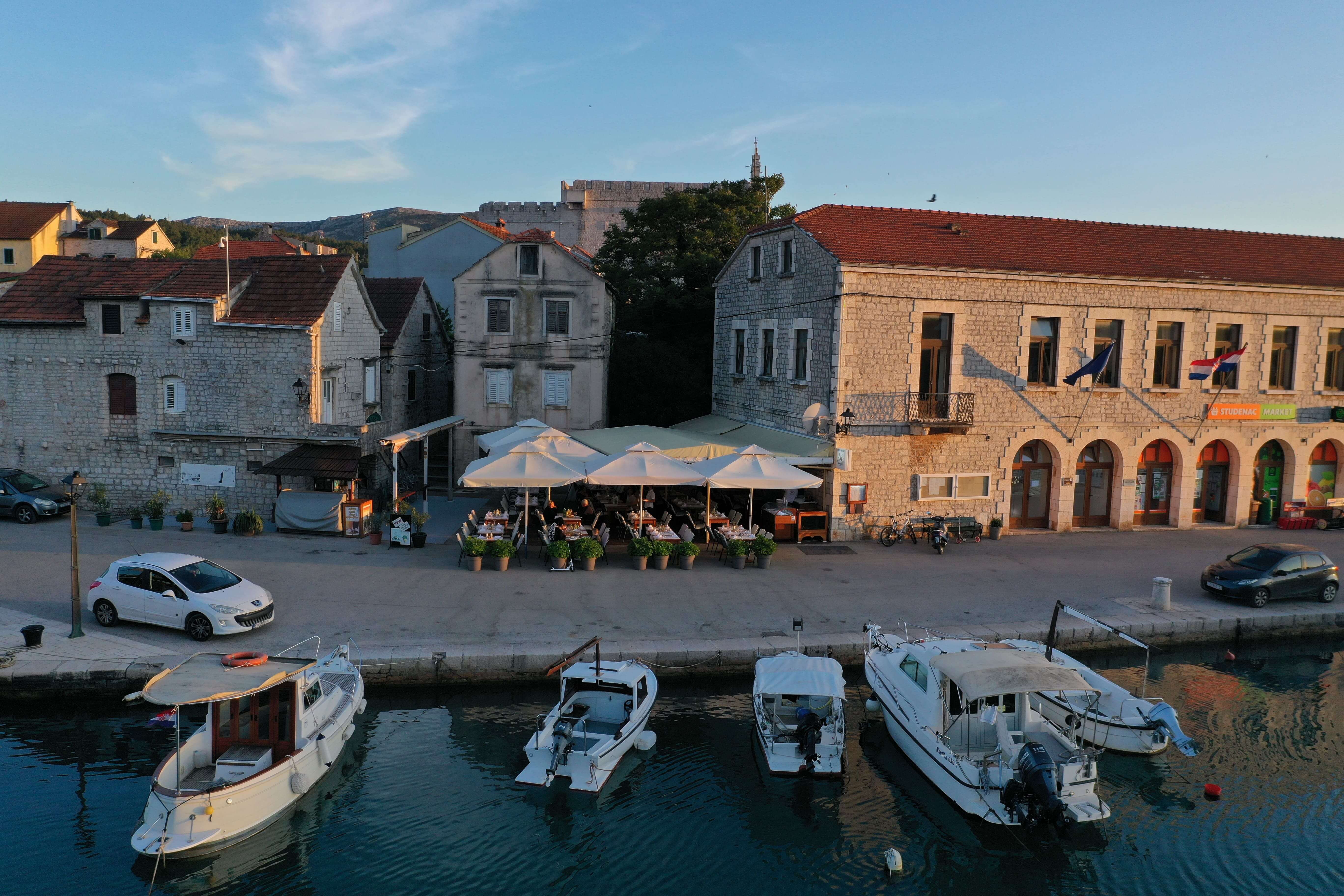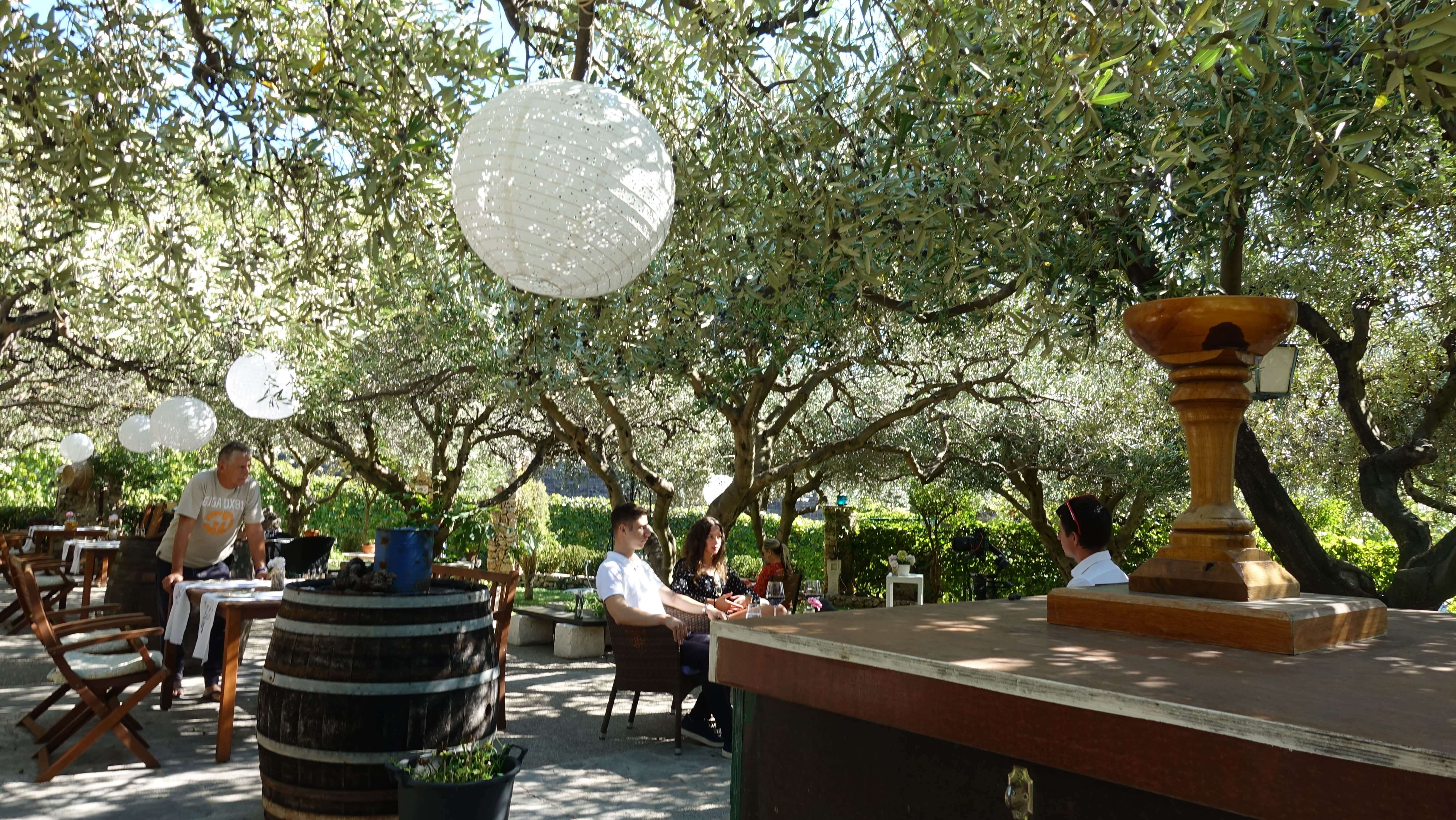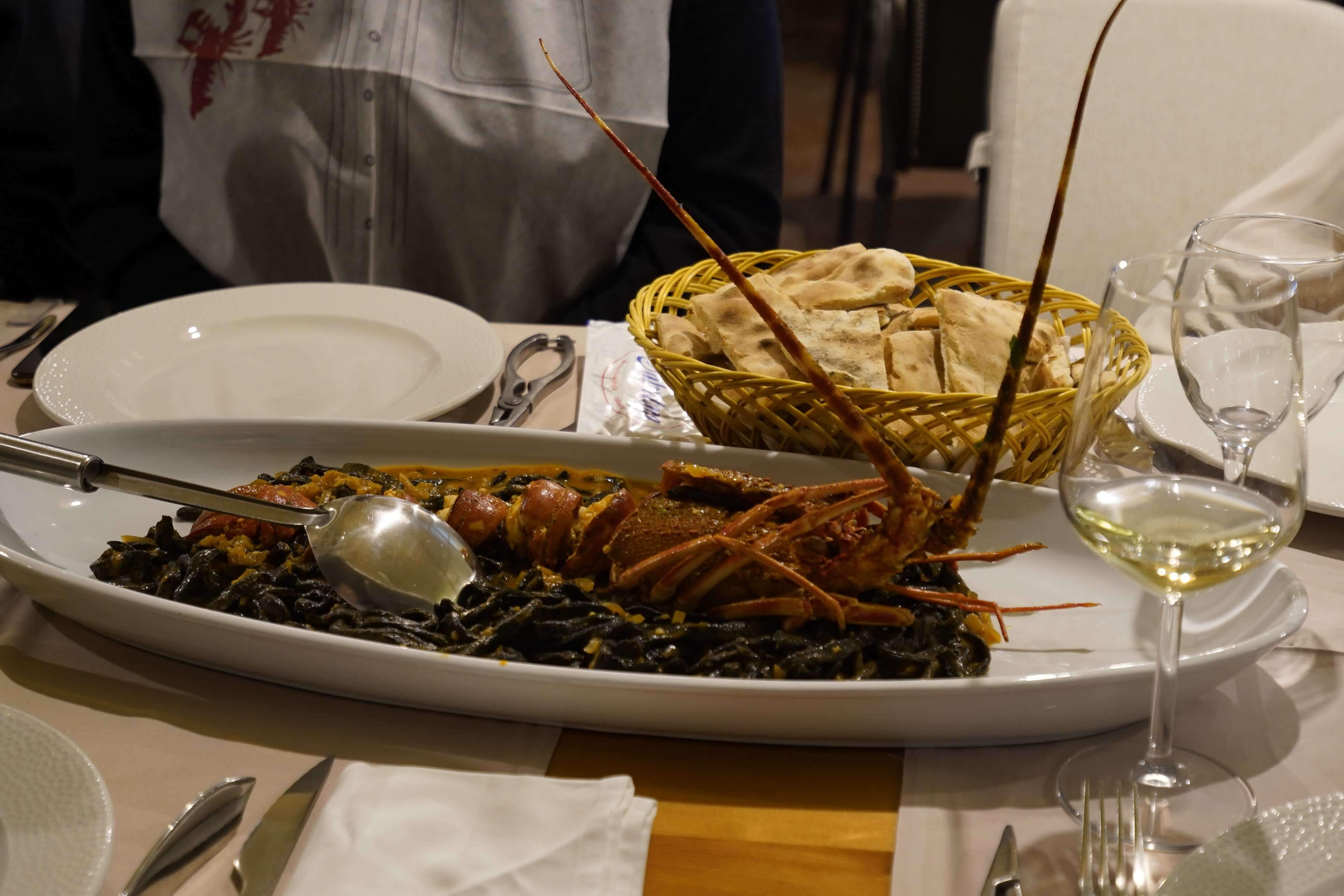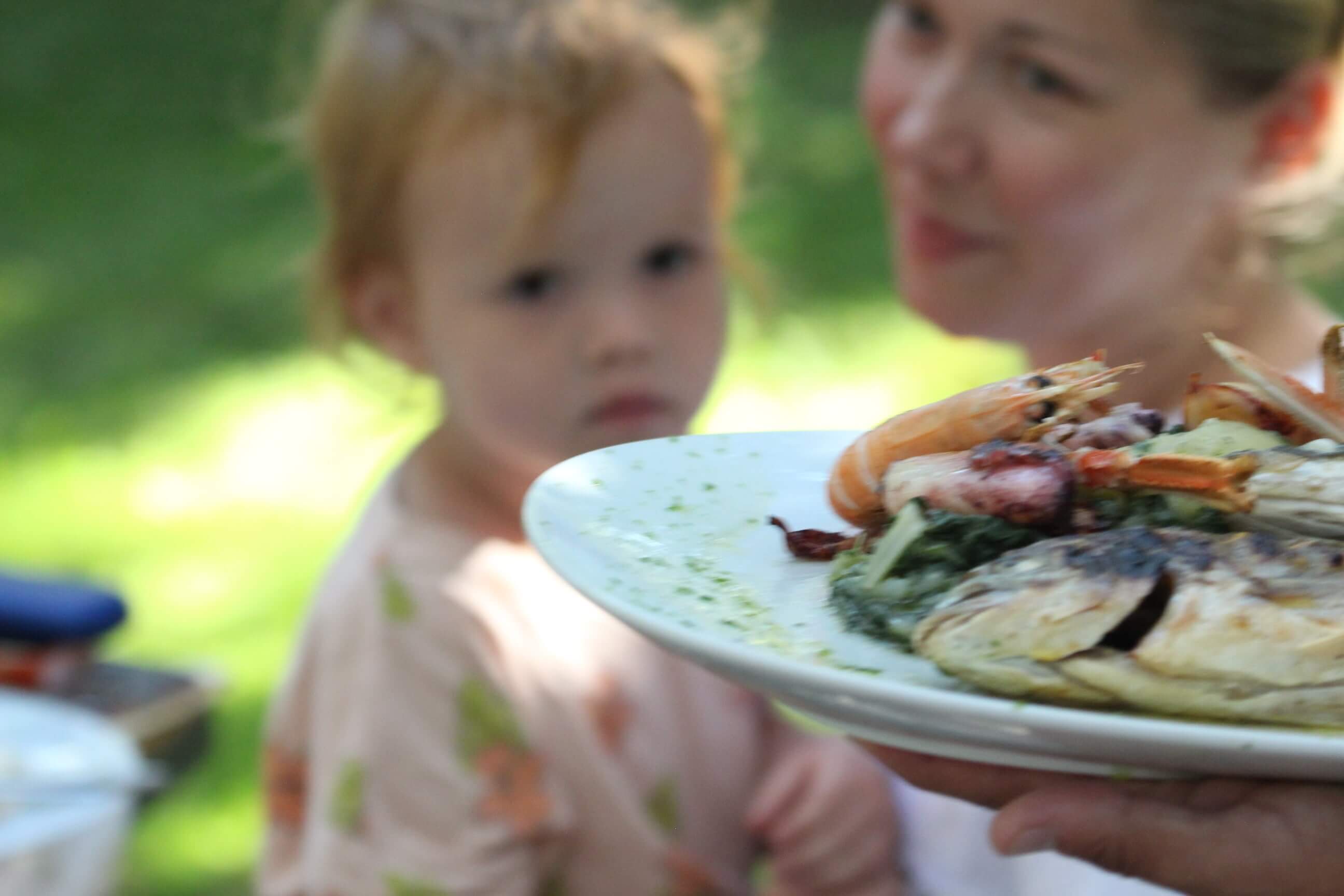Potential Croatian Workers ARE Available, But Not for Minimum Wage...
December the 7th, 2021 - We often hear all about how employers just can't get the staff and need to instead go into battle with MUP's pen pushers in order to hire third country nationals from Bosnia and Herzegovina and Serbia, but is that really the case? Not always. There are plenty of would-be Croatian workers, but they aren't about to jump for joy working for minimum wage with no days off.
As Poslovni Dnevnik/Marija Crnjak writes, the search for Croatian workers in tourism for the next summer season has never started earlier than now - all tourist companies typically use the low season for active searches not only for seasonal workers but also for a permanent workforce that can expect better conditions than in they had over the last two years.
Hotels offer slightly higher salaries, and are looking for seasons which span a more generous period of 4 to 7 months, which suggests that they are counting on a decent tourist season in summer 2022.
However, their task is not easy, with the continuation of the trend of migration of Croatian workers to the west, the pool of workers from Serbia and Macedonia has been significantly reduced, whose work in Germany and Austria has also been much more simplified since this year.
At the same time, this year the trend of emigration of German and Austrian workers to Switzerland, where higher salaries are offered, has intensified. This is just a part of the insight into the lively labour market revealed by Natasa Kacar, the director of the employment agency Gate2Solutions and the Job in Tourism portal, one of the leading platforms that connects supply and demand for workers here in Croatia and across Europe.
"At this time of year, we mostly dealt with the winter season at ski resorts, and this is a really unusually active autumn for Croatian employers. It is completely different than last year, when it was not known when and how the season would start, and the search for Croatian workers started practically with the very arrival of the season, and as such, there was chaos.
We're now noticing a lot more optimism from employers for next year, but also fears that they will be left without Croatian workers again. At the same time, there are more Croatian workers out there willing to do a goo job than it seems, but they can no longer allow themselves to be exploited and that is the basic thing that employers must keep in mind,'' points out Kacar.
"Posao u turizmu/Jobs in tourism" has been uniting a dozen local and foreign employment agencies as a specialised portal and mediation agency for six years now, and in addition to Croatia they are present in Bosnia and Herzegovina, Serbia, Macedonia, Montenegro, Slovenia, Switzerland and Austria through their agents and branches. They're also active in Germany, Malta, Ukraine, India and even in Dubai.
The founder of the portal is Tin Tomljanovic, an award-winning Croatian bartender. The combined base and channels through which they communicate the needs of workers ensure that they quickly find workers for their partners. They also offer the possibility of importing workers from other EU member states and from third countries, from Turkey, Greece, Bulgaria, but also Ukraine, the Philippines and Thailand.
They mediate not only in the employment of seasonal workers, but also in permanent employment for an indefinite period. Natasa Kacar also claims that they are contacted by Croatian emigrants who would like return home, but having experienced life (and salaries) abroad, they have their own conditions.
“Those who emigrated to work in Austria, Germany, Switzerland, Ireland, cruise workers... they all clear employment conditions there, from wages higher than there, to accommodation and food, and they of course got used to one or two days off per week. With the exception of mostly large serious companies, in Croatia there is generally no guarantee of a salary, which is usually the minimum wage, and the rest is paid in hand. There are often no days off, especially during the height of the summer season, and work is done without a break for 12-14 hours when there are many people around. In Switzerland, work is carried out for 9 hours with a break of 50 minutes, which must be used because otherwise employers risk fines, if they work in hotels, then they're free for two days a week every week.
Croatian workers now know exactly where and what they're going for. When I tell my employer that I don't have a worker who will work without a break and a day off, restaurant owners can say that the nature of the job is such that it is done without a break. Maybe it can be like that for the owners, bur the workers no longer agree to that, especially the younger ones, and employers have to be ready for that,'' says Kacar.
Besides, salaries outside of Croatia's borders are typically much more attractive. A recently announced tender published on the portal is one which is looking for chefs, bartenders and waiters for the winter season over in Switzerland, for seasonal jobs with the possibility of permanent employment. Salaries range from 3,900 to 4,400 euros gross (minus 13-20 percent to the net amount), accommodation and meals are provided at an additional cost, as employers co-finance the rental of all apartments.
In Austria, a head waiter typically receives about 1,900 euros net, in Croatia they work just as hard only to take home somewhere between 7,000 and 9,000 kuna, while maids work a maximum of 8 hours a day in the sweltering Croatian summer heat with just one day off.
For more, make sure to check out our dedicated business section.
Seven Billion Euro Investment in Croatian Agriculture Possible
December the 6th, 2021 - There could be a big cash injection for Croatian agriculture, which the vast majority of people working in that sector would readily explain is dearly needed...
As Poslovni Dnevnik writes, the Republic of Croatia will send a strategic plan to the European Commission (EC) by the end of this year, which will define the direction of spending money on Croatian agriculture, according to an analysis by the consulting company Smarter from which they point out that this is a document that will largely determine the direction of development of agricultural production by the end of the decade.
"The CAP Strategic Plan is the most important document for the medium term, which determines the financial envelopes, measures and interventions that will be implemented and how the financial resources for Croatian agriculture will be directed," the analysis points out.
Smarter reminds that in five years, from 2023 to 2027, Croatia, not counting state funds, will have a massive 3.25 billion euros at its disposal, with slightly more than 1.5 billion euros intended for rural development, and 1.87 billion for direct payments.
For 2021 and 2022, a total of 1.75 billion euros has been provided for Croatia on the basis of a regulation extending the application of the rules from the previous period, but in such a way that money from the new multiannual financial framework will be distributed under the same rules.
The total funds from the EU budget from 2021 to 2027 amount to 5.17 billion euros, and in addition, through the National Recovery and Resilience Program for Agriculture, 131 million euros are intended, according to Smarter.
Thus, significant investments exceeding 5.3 billion euros from EU funds can be expected for Croatian agriculture.
"It's realistic that more than seven billion euros or over 52 billion kuna will be invested in Croatian agriculture from 2021 to 2027, which gives us an opportunity to make a serious turn towards that and implement the activities necessary to make agriculture more competitive, productive and fulfill its full portential,'' reads Smarter's analysis.
For more, check out our dedicated politics section.
Istrian Winemaker Ivan Damjanic Strengthening Position on Montenegrin Market
December the 7th, 2021 - The very well known Istrian winemaker Ivan Damjanic is set to strengthen his position on the neighbouring Montenegrin market.
As Poslovni Dnevnik/Marta Duic writes, back in mid-November, Istrian winemaker Ivan Damjanic travelled south down to Montenegro as part of the project "Wine Envelope and Measures" which is the promotion of wine in third country markets to acquaint consumers there with their labels.
It's worth mentioning that promotion on the markets of third countries refers to wines with a protected designation of origin, geographical origin and wines with an indication of the grapevine variety produced in Croatia.
Istrian winemaker Ivan Damjanic held four eno-gastro presentations, which included the pairing of various dishes and his wines, and the list of restaurants that hosted Damjanic included Conte in Perast, Cattaro in Kotor and Podgorica's Restaurant 100 manira i Hemera.
The audience included renowned wine connoisseurs, sommeliers, caterers, hoteliers, bloggers, journalists and other wine lovers. While some of the wines, such as Damjanic's Malvazija, are already fairly well known to the Montenegrin audience, some labels of this popular Croatian winery have yet to find a place on that particular market.
The audience thus tasted labels such as Borgonja, Dura Istriana, Clemene blanca, Clemente and Suncerus, which will soon be on the shelves of Montenegrin wine shops. By the way, the winery or perhaps better to say the Damjanic family farm has existed since back in 2004, and their vineyards currently cover 10.5 hectares.
The last investment was in the reconstruction of the vineyard and equipping the winery, also as part of the wine envelope.
"Before the coronavirus pandemic struck, we exported about 25 percent of our production to Montenegro, the United States, Germany, Austria and Poland. This has slowed down a bit at the moment, but the Canadian market has opened up for us in the last two years.
We currently have eleven labels and the most sought after are Malvazija, Borgonja, Clemente and Clemente blanc. We cooperate with many people in the catering industry and hoteliers throughout Croatia, and guests from all over the world come to our tasting room. Most of them are from Germany, Austria, Switzerland, the Netherlands and Italy,'' Istrian winemaker Ivan Damjanic said.
For more, make sure to check out our dedicated business section.
Croatian Podravka Brand Hopes to Conquer Wealthier European Markets
December the 7th, 2021 - The Croatian Podravka brand is aiming to strengthen its position on the more wealthy European markets, and Martina Dalic says this is an ambitious goal of hers.
As Poslovni Dnevnik/Jolanda Rak Sajn writes, an even bigger and stronger Croatian Podravka brand is an ambitious goal that has been entrusted to the new President of Podravka, Martina Dalic, since the beginning of this year. This aim has the strong support of Prime Minister Andrej Plenkovic and the pension funds, which are the main shareholders of the Koprivnica food giant.
Behind the prematurely deceased Marin Pucar, one of the most important regional companies, which is the holder of most of the development of a good part of the Croatian food and retail industry, remained on good foundations, with excellent results and a stable position across many markets.
However, even in this difficult and uncertain year affected by the coronavirus pandemic, the Croatian Podravka brand has maintained high growth rates with even greater focus on consumer preferences and conquering potential markets in Western and Central Europe while maintaining a dominant position and strengthening competitiveness in the Adria region where Podravka has been in business for more than 70 years,
In the first nine months of this year, the Podravka Group generated a net profit of 259.3 million kuna, 23.4 percent more than in the same period last year. Sales revenues amounted to 3.38 billion kuna, as well.
The Nutrition segment generated 2.6 billion kuna in revenue and Pharmaceuticals generated 749.5 million kuna, with the largest contribution from the Prescription Medicines category, which increased by 5.4 percent in total. Revenues from the sales made by Podravka d.d. in the first nine months of 2021 amounted to 1.65 billion kuna, which is 3.9 percent more than in the same period last year.
Just like last year, due to the epidemiological situation, there was an increase in demand for Podravka's products and the creation of large stocks of customers in almost all markets, and this year's growth has been even more significant.
Compared to pre-pandemic 2019, revenues grew even more, by 5.4 percent, and sales revenue growth was achieved in almost all business programmes. In the Western Europe region, it amounted to 9.5 percent, and the highest growth was generated by the Culinary, Podravka food and Baby food, sweets and snacks segments.
In Central Europe, growth stood at 4.4 percent, and in the Adria region 2.9 percent. The price of a Podravka share on September the 30th this year amounted to 664 kuna, and on the last day of 2020, it was 485 kuna, which is an increase of 36.9 percent.
In accordance with the Strategic Plan of the Podravka Group for the period 2021-2025, adopted after the arrival of Dalic, the company began investments worth 5 billion kuna in production and logistics modernisation and digitalisation, marketing and acquisitions.
The five-year plan includes both divisions of the group, Nutrition and Pharmaceuticals (Belupo), through three development pillars - about 1.7 billion kuna of investment in the modernisation and digitalisation of production and logistics processes, about 1.4 billion kuna in marketing for organic growth and around 2 billion kuna for acquisitions.
The future rapid growth and development of the Podravka Food Division will be based on product categories with greater export potential such as food additives, soups and bakeries, and a focus will be placed on Europe's richer markets. Self-sufficiency will be increased through agricultural production and cooperation will be strengthened in order to reduce import dependence and stably manage risks in the primary part of the supply chain, including through the use of EU funds.
The Croatian Podravka brand recently received 19.4 million kuna in grants from the Rural Development Programme for the modernisation of fruit and vegetable processing plants, the development of new technologies and new products of Kalnik with a total value of more than 38 million kuna, and 5.2 million kuna for the construction project involving solar power plants, worth a total of 10.33 million kuna.
Belupo, on the other hand, is preparing for stronger growth across Central and Western Europe.
For more, check out our business section.
Remembering Oliver Dragojević on His 74th Birthday
December 7, 2021 - Remembering Oliver Dragojević on December 7, what would have been his 74th birthday.
It has been three and a half years since Oliver Dragojević has been gone. For his birthday on December 7, we remember the music legend who touched the region with his timeless songs, charm, and simplicity, writes Gloria.
Since he lost the battle with cancer in July 2018, he has remained immortal to the people of Split. Oliver could never imagine leaving his beloved Split, although he was offered countless times to move to Zagreb and even some larger European capitals.
Oliver loved Split and especially appreciated that the life of an "ordinary" man could live there. He went out for coffee with his family every day, visited the fish market, and often sat on a bench on the Riva, enjoying the sea view and boats.
Neighbors on the street, where he had lived for the past twenty-something years, said he would greet any passerby, whether he knew him or was in a hurry. "I would never move out of Split because I enjoy it. As soon as you live in Split, and if you live, you can't be an uncommunicative or conceited star," Oliver said.
We cannot forget how much he loved Vela Luka on Korčula, which was his permanent home until he was two years old, and where his mother Kata, a cleaner, and father Marko, a worker in the Port Authority, were from. Oliver was their fifth and youngest child.
His three sisters died before he was born, and his brother Aljoša, who also died from cancer in 2011, was three years older than him.
Vela Luka was his oasis of peace in which, as an adult, Oliver spent every summer with his family. At his request, he was buried in the local cemetery of Sv. Roka. His grave is regularly visited by his fans from all over Croatia and beyond.
Talking about their plans for old age, Vesna Dragojević admitted that the two of them intended to spend the rest of their lives in Vela Luka, which is why they bought another house there more than ten years ago. Since his death, her sons, daughters-in-law, and grandchildren have kept her company.
"With me are sons Dino and Damir, their wives Nevena and Vanda, Dino's children Duje, twins Lucija and Toni and Damir's little ones Vinko and Margita. And Davor, his wife Karmen, and their sons Marko and Luka who are staying with Karmen's parents visit every day," Vesna revealed to Gloria this summer, on the third anniversary of Oliver's death, when many musicians perform in Vela Luka to honor the music legend.
Oliver was a passionate lover of the sea and always pointed out that he needed no luxury but a boat and fishing rods to catch big fish. While his former boat was moored in the ACI marina in Split, he often spent part of the day in the cabin watching his favorite TV series "Malo Misto." His singing partner and great friend Zlatan Stipišić Gibonni called him 'captain' in his farewell speech.
"I would like to tell my Captain that everything is as it should be. And that all this sea is just for him," Gibonni said sadly at the commemoration for Oliver at HNK Split in August 2018.
People close to Oliver will always say first that he was a family man above all else. He spent a full 44 years married to Vesna, and in 2009 they secretly renewed their marriage vows in the church in Vela Luka.
When they fell in love in her hometown of Dubrovnik, Oliver performed with the band Batali and was unknown to the general public. He was 25 at the time, and Vesna was six years younger. They had a modest wedding in Oliver's parent's apartment in Gripe and shared the first years of their marriage with his brother Aljoša and his family.
In an interview with Gloria after Oliver's death, Vesna said that the secret of their marriage was that they had the same views. They did not drive expensive cars and clothes but secured a future for their sons Dino and twins Davor and Damir. Oliver also helped Vesna get through the most challenging periods - a stillbirth in the first year of marriage.
"I remember best our last sixteen years when he decided to pull the brakes and perform less and be with us more. I was always happy and fulfilled with Oliver. I don't know any man who was so easy to love. He didn't have to do anything special to feel comfortable next to him," Vesna said in 2019 when she emphasized that Oliver was the most tender father in the world. He never raised his voice or said a harsh word.
Everyone knew about Oliver's devotion to his family in Split because he always walked around the city in the company of his son or Vesna.
"My sons have always come first, and the best thing I could do for them is to let them choose their path. I don't mind that they chose tourism instead of music. But that's why I gave them the sea and fishing," joked Oliver, who enjoyed his role as a grandfather in his later years.
His oldest grandson Duje was born in 2007 and is now in the eighth grade, and the youngest Luka is a year and a half old. Oliver did not welcome his birth, as well as three-year-old Marko, but there is no doubt that he would adore them, as well as his other five older grandchildren.
Since Oliver's departure, many of his colleagues have claimed there is no other musician like him - a legend during his lifetime. His career lasted for half a century; he won as many as 31 Porin and his favorite Split Festival many times. His incredible musical journey began in 1975 when he performed an anthological song by the late Zdenko Runjić, "Galeb i ja”.
Oliver graduated from music high school, played the harmonica, piano, guitar, and clarinet, and is our only singer who has performed in the world's most famous concert halls: New York's Carnegie Hall, London's Royal Albert Hall, Paris' Olympia, Vienna's Konzerthaus and opera in Sydney.
In addition, the audience and critics adored his vocals with which he painted all his songs: from the older "Magdalena", "Ključ života," and "Ostavljam te samu" to "Cesarica." However, this 1993 song, written for him by Gibonni, was a new turning point in his career - as younger generations began to listen to him.
"To last in music, you need to have a good song, believe in what you're doing, and be persistent as a horse. I didn't plan anything in my career. My vocal cords just spent a lot of singing, sleepless nights, and cigarettes," Oliver once said.
At the end of 2017, he was to hold two celebratory concerts at the Spaladium Arena to celebrate 50 years in music and his 70th birthday. The last time he appeared in front of the audience was at a show for the fight against cancer at the Croatian National Theater in Split in October 2017. Vesna saw symbolism in that because he held over 400 humanitarian concerts during his lifetime.
Oliver's 357 days battling lung cancer are still reluctantly remembered by his loved ones. The world collapsed for their family when they found out about Oliver's diagnosis in August 2017. There was no doubt that they faced a much more significant challenge than when Oliver suffered a mild stroke in 2003.
"I am a nurse by profession, and in ten years of work, I have seen many patients with this diagnosis who have not been cured. Oliver's disease was a shock to all of us because he was in great shape that summer. He always played futsal; he smoked less and got rid of alcohol long before that," Vesna admitted two and a half years ago. His desire to live, sing and honor the sea did not leave him even when in the summer of 2018 - after several hospitalizations and hard struggles - he ended up in the hospital for the last time, where he eventually died on July 29 at 4 am.
Oliver's farewell is remembered as unparalleled. Hundreds of thousands of people who gathered on the Riva said goodbye to the adored musician, and almost all of his colleagues were among them.
His coffin was transported to Vela Luka by a special catamaran, which was accompanied by sirens and bells from the St. Duje Cathedral and by small boats and ships of the Ministry of the Interior and the Croatian Navy. Torches colored the sky above Split, and Torcida organized the spectacle as Oliver was a passionate supporter of Hajduk.
Split will sing his songs in his honor, together with Oliver's nephew Petar Dragojević, at Zvončac tonight.
To read more about lifestyle in Croatia, follow TCN's dedicated page.
Croatia Men's Basketball Team Opens EuroBasket 2022 in Milan
December 7, 2021 - The EuroBasket 2022 will be held in September next year in Italy, the Czech Republic, Germany, and Georgia. Croatia will open the tournament in Milan against Greece, Great Britain, Estonia, Italy, and Ukraine.
The schedule for the 41st edition of the European Basketball Championship (EuroBasket), which will be held from September 1 to 18 next year in Italy, the Czech Republic, Germany, and Georgia has been announced. The Croatia national basketball team has already qualified for this competition.
Namely, Croatia will play in Group C at Eurobasket, and all five games will be played in Milan's Mediolanum Forum.
Veljko Mršić's selected team will face Greece in the first round on September 2 at 5:00 pm. A day later at 2:15 pm, Croatia will face Great Britain. The third round is scheduled for September 5, and Croatia will play against Estonia, again at 2:15 pm.
In the 4th round, on September 6, Croatia will play against the host Italy (9:00 pm), and in the last round two days later against Ukraine starting at 2:15 pm.
Spain, Russia, Turkey, Georgia, Belgium, and Bulgaria will play in Group A in Tbilisi.
Germany, France, Lithuania, Slovenia, Hungary, and Bosnia and Herzegovina will fight in Group B in Cologne. Group D matches will be played in Prague, and Serbia, the Czech Republic, Poland, Finland, Israel, and the Netherlands will compete.
The four best national teams from each group will advance to the round of 16. The national teams from Group C, which includes Croatia, will cross over with the teams from Group D, led by Serbia.
The European Championship continues in Berlin from the round of 16.
SCHEDULE OF GROUP MATCHES:
Round 1 - September 2:
Ukraine - Great Britain (14:15)
CROATIA - Greece (17:00)
Italy - Estonia (21:00)
Round 2 - September 3:
Great Britain - CROATIA (14:15)
Estonia - Ukraine (17:00)
Italy - Greece (21:00)
Round 3 - September 5:
CROATIA - Estonia (14:15)
Great Britain - Greece (17:00)
Ukraine - Italy (21:00)
Round 4 - September 6:
Estonia - Great Britain (14:15)
Greece - Ukraine (17:00)
Italy - CROATIA (21:00)
Round 5 - September 8:
CROATIA - Ukraine (14:15)
Estonia - Greece (17:00)
Great Britain - Italy (21:00)
To read more about sport in Croatia, follow TCN’s dedicated page.
British Airways Zagreb Flights Briefly Resume in December, Aeroflot Runs Daily from 23rd
December 7, 2021 - The latest flight news to Croatia as British Airways Zagreb flights resume in December, and Aeroflot will operate between Moscow and Zagreb daily from December 23.
The British national airline and OneWorld alliance member British Airways resumed regular flights between London and Zagreb in early December, reports Croatian Aviation.
Namely, on December 2 this year, a British Airways A320 aircraft landed again at Zagreb Airport with a total of 103 passengers after a short break. Since the beginning of the pandemic, British Airways has often made operational changes in its flight schedule, with most changes to its Zagreb route, which has been suspended several times for a shorter or longer period.
Zagreb suffered the same fate this autumn, but British Airways has resumed traffic on the route to Zagreb, expecting higher demand in December, as is usually the case, due to the Christmas holidays and New Year's celebrations.
Thus, from December 2 to 31, British Airways will operate a total of 14 return flights between Zagreb and London and offer an additional 5,000 seats. Along with British Airways, Croatia Airlines also operates on this route four times a week, while the Irish low-cost carrier Ryanair flies between Stansted and Zagreb.
According to current announcements, British Airways will stay in Zagreb until January 10 (flights on Mondays, Tuesdays, Thursdays, and Sundays), and then will cancel the route again. For now, only until February 1, but it is expected that the airline will extend flights to Zagreb until spring.
Furthermore, Croatian Aviation reports that the Russian national airline Aeroflot will operate daily between Moscow and Zagreb from December 23 this year.
Aeroflot will send wide-body A330-300 aircraft to Zagreb this December, all due to the increased passenger demand when Russian citizens flocked to the Croatian capital in large numbers for vaccines.
In addition to the previously announced A330-300 aircraft, which will arrive in Zagreb on December 9 and 12, the third A330-300, which will land in the Croatian capital on Thursday, December 16, has been announced in additional changes.
By the end of this year, Aeroflot will offer more than 7,200 seats between Moscow and Zagreb on a total of 19 return flights, with 3 return flights with wide-body aircraft that we could see daily at Dubrovnik Airport this summer and on the last day of the summer season in Split.
So far, Aeroflot has rarely sent wide-body aircraft to Zagreb, but this was mainly due to cargo. In the winter of 2019, Aeroflot flew to Zagreb on a daily basis using Sukhoi Superjet 100 aircraft.
For more on flights to Croatia and other travel announcements, make sure to check out our dedicated travel section.
Visiting Rijeka in Winter? Here’s What to See, for Free
The Rijeka Winter Pass grants free admission to a number of city’s attractions to all visitors staying in Rijeka for more than two days in the winter months. Check out our detailed overview of all the attractions included in the offer and enjoy exploring ‘the city that flows’
TCN recently reported that the Rijeka Tourist Board launched a Winter Pass, a special promotion that includes free admission to a dozen attractions in the city.
Anyone who books accommodation in Rijeka (min. 2 nights) before March 31st 2022 will be sent a QR code upon arrival. The code provides free entrance to several museums and other popular attractions in Rijeka - more info here.
It’s a great offer, reflecting just how much there is to see in the charming port city in the offseason. Considering booking a trip to Rijeka? We prepared a detailed overview of all the attractions included in the Winter Pass, grouped by location for your convenience.
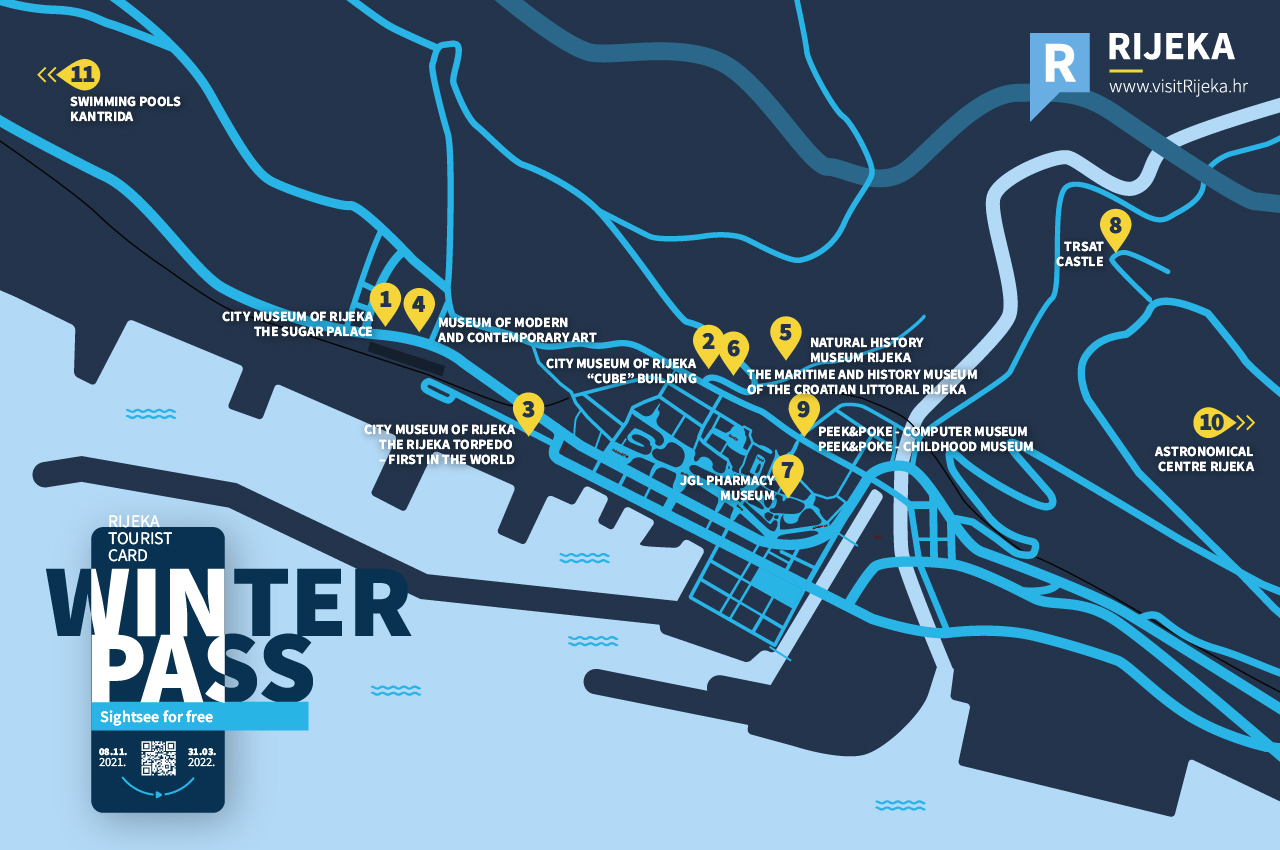
Starting downtown across the street from the main railway station, we’ll first head to the former industrial compound that’s well on its way to transforming into a lively cultural district.
The Rikard Benčić complex consists of several buildings that used to house some of the most prolific manufacturing plants in the city, such as the sugar refinery, the tobacco factory and the factory of engines and tractors. After they’d all closed down, the location was neglected for decades until a massive reconstruction project kicked off a few years ago.
The new art quarter will consist of two museums, the city library and a children’s house. We’ll start our tour with two cultural hotspots included in the Winter Pass that have already moved into their new homes.
City Museum of Rijeka: The Sugar Palace
If your stay in Rijeka only allows for one museum visit, make it this one - and not just because of the appealing name.
Housed in the seat of the former sugar refinery, the new permanent exhibit of the City Museum of Rijeka was introduced in 2020 and has already won over the locals and tourists alike.
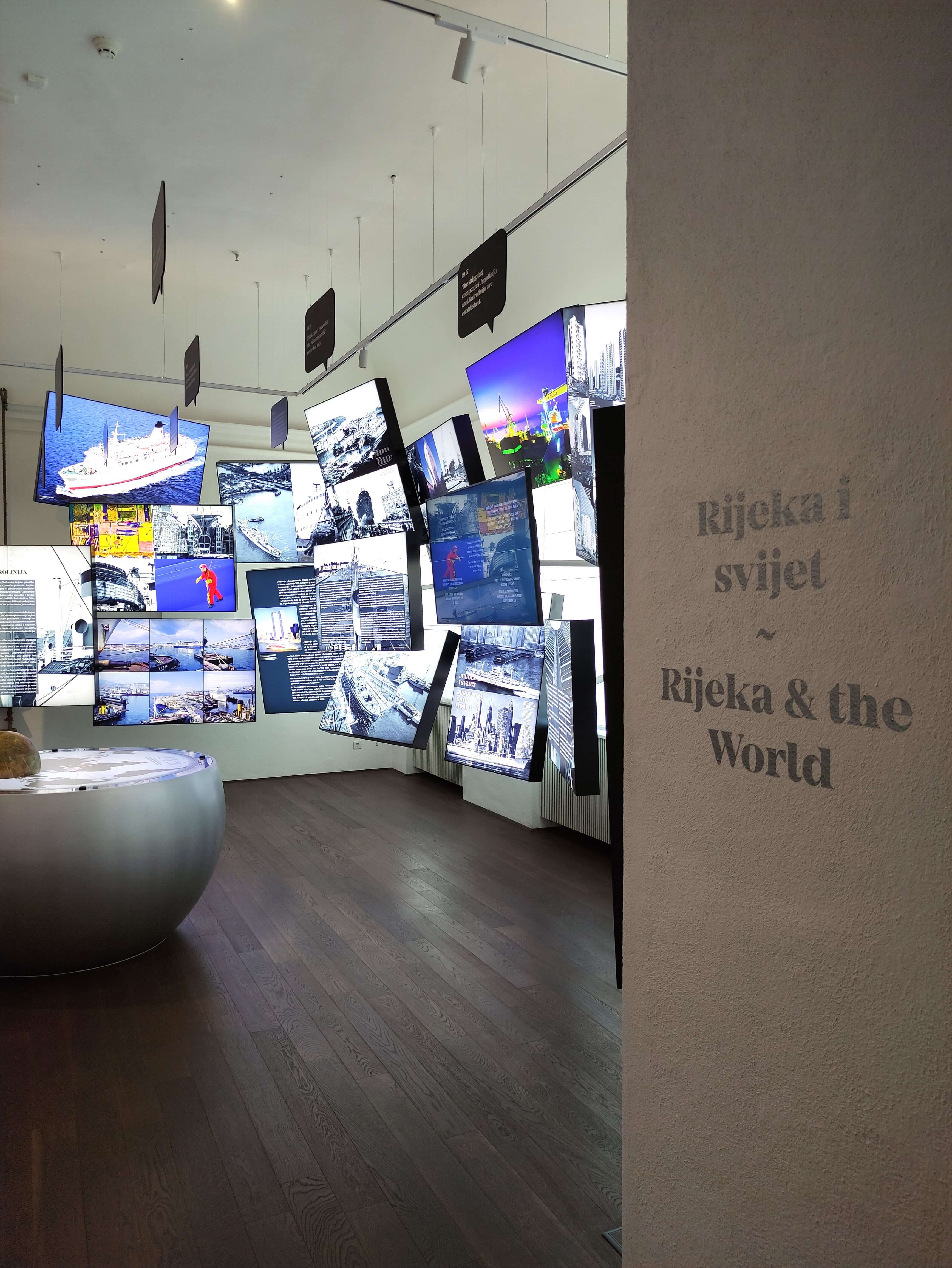
The city’s history is laid out chronologically and in themed sections covering various facets of life in Rijeka through the ages. Highly interactive and never boring, the collection offers insight into the local culture and presents historical events in a captivating way.
You’ll see why the museum refers to the exhibit as a ‘playful time machine’; each room is a little world of its own. Groundbreaking inventions, touching stories of emigration, political turmoil, inception of advertising, local cuisine, music legends… There’s always more to discover around the next corner of the gorgeous historical palace.
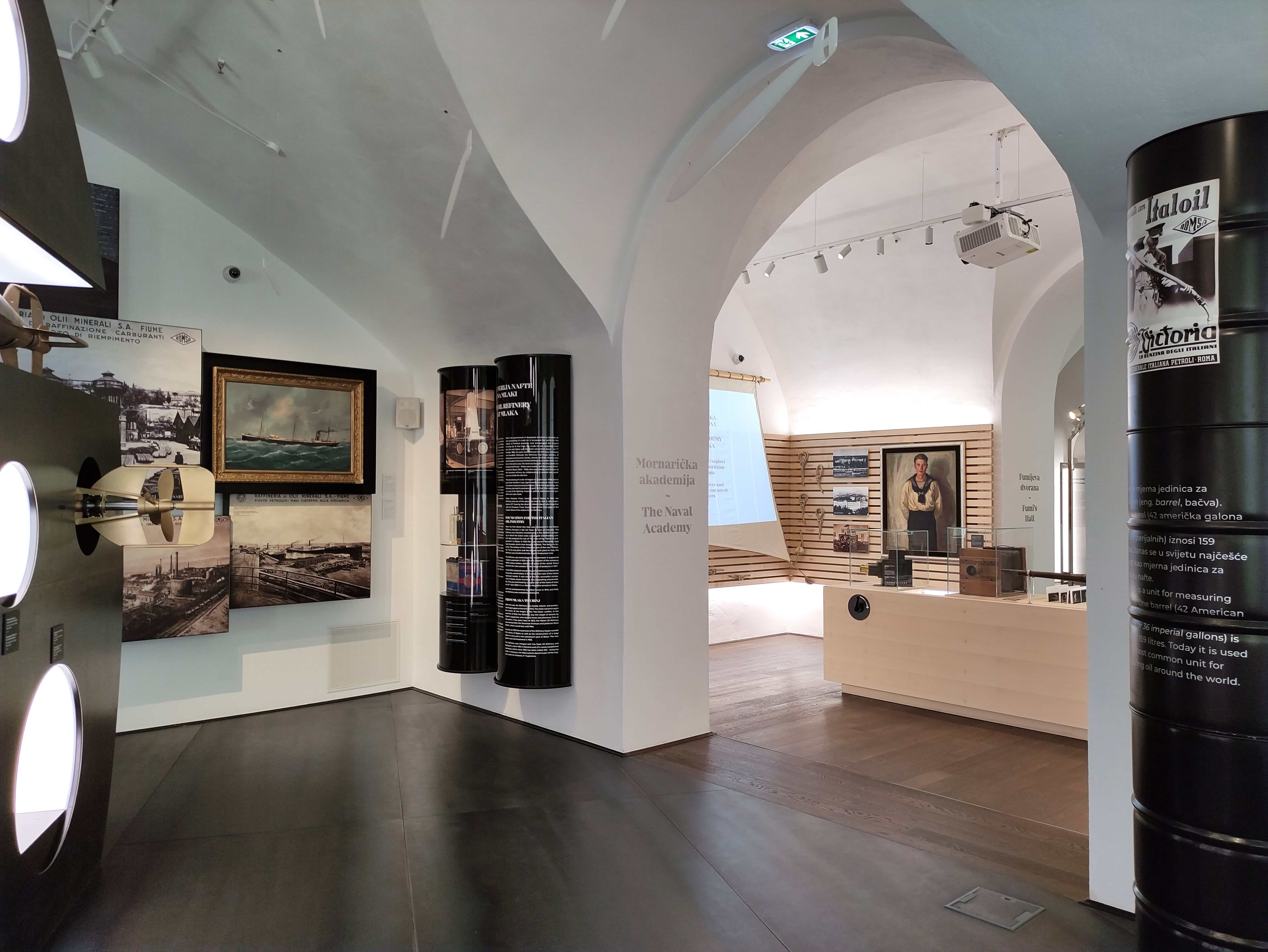
Kids will love it too - there are games, quizzes, music booths and other interactive content scattered around the exhibit.
Working hours: Tuesday to Sunday, 11am to 6pm
Address: Krešimirova 28
Website: City Museum of Rijeka
Museum of Modern and Contemporary Art
Wandering around a city for the first time, some locations can be hard to find. Not the Museum of Modern and Contemporary Art - just look for the brightest, loudest, reddest facade in town.
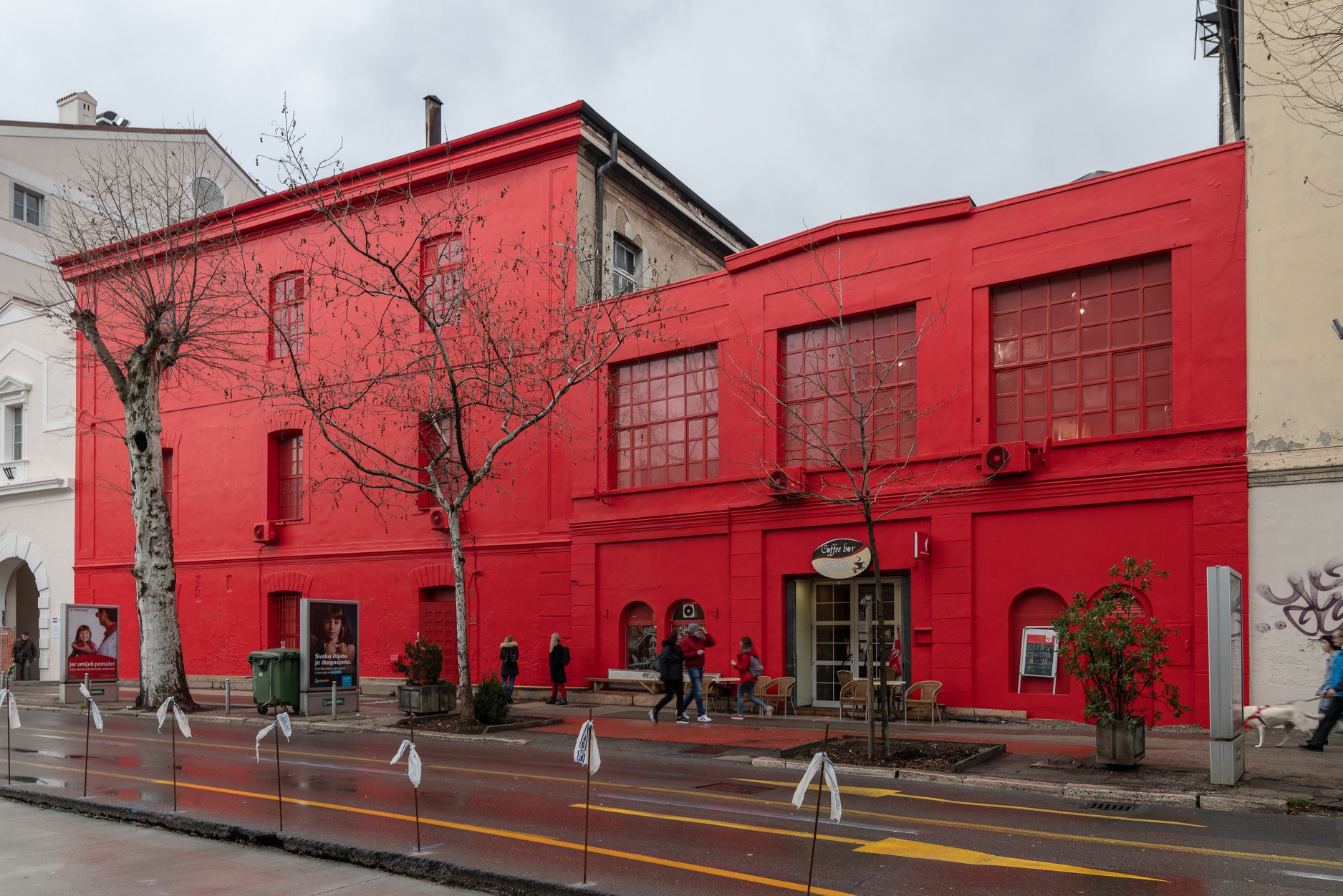
The red facade is a work of artist Dora Budor named Red Monochrome (There’s something terrible about reality and I don’t know what it is. No one will tell me.). Photo: PJ Rountree, source: MMSU
Having changed location several times since its inception, Rijeka’s Museum of Modern and Contemporary Art finally found a home it deserves in the newly restored H-building at the former industrial compound Rikard Benčić.
The new environment grew organically: the museum adopted a philosophy named ‘we need it - we do it’, presented as part of the Croatian pavilion at the 2016 Venice Biennial of Architecture. Essentially, the MMCA moved to its new home as soon as conditions allowed it once the basic renovation works were completed.
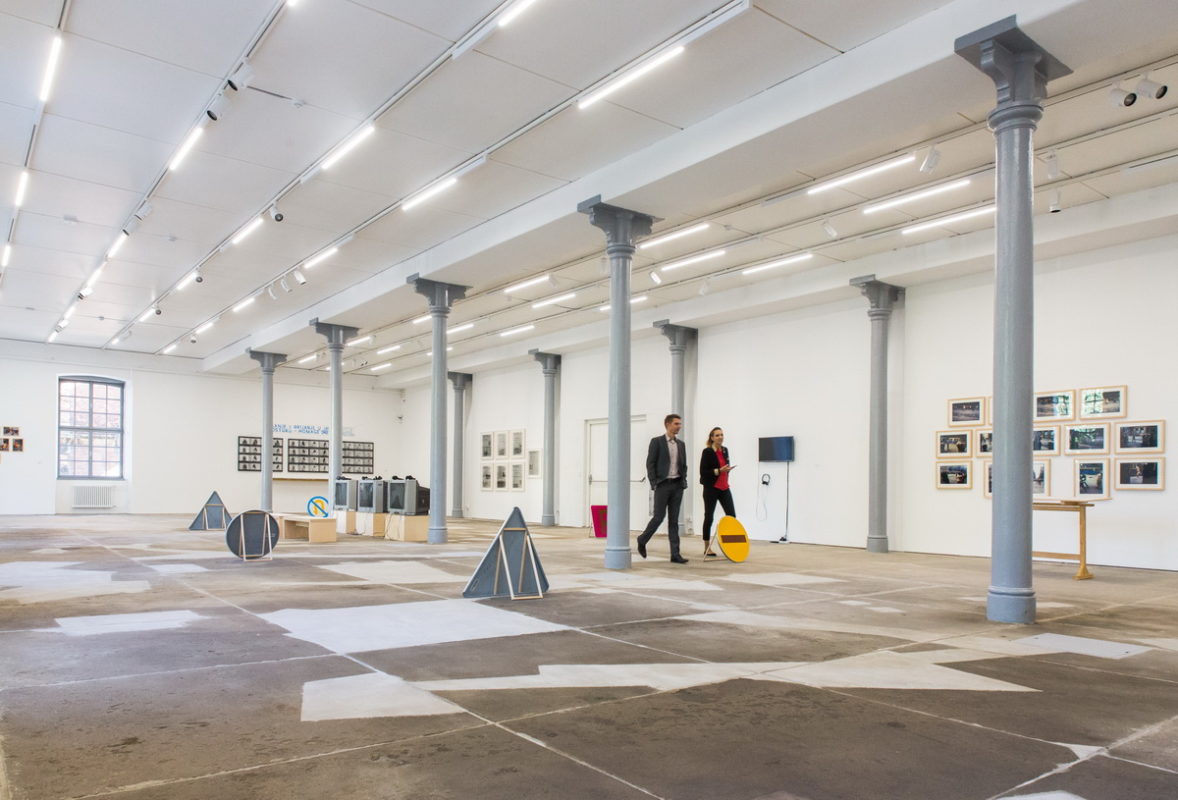
© City of Rijeka (rijeka.hr)
From that point on, the museum and its home have been developing gradually and attuned to the needs of the community. MMCA is equally dedicated to celebrating champions of modernism and showcasing the work of up-and-coming contemporary artists.
What’s on at the moment? Don’t miss the video retrospective of Sanja Iveković, titled Make Up - Make Down after one of her famous works. Iveković has had a prolific artistic career mostly focusing on photography, video and performance, and she’s also the first Croatian female artist to get a retrospective at New York’s MoMA.
Working hours: Tue – Fri: 12 am – 7 pm, Sat – Sun: 12 am – 5 pm
Address: Krešimirova 26c
Website: Museum of Modern and Contemporary Art
Exit the Benčić complex and head towards the main bus station for the next item on our list:
Rijeka Torpedo – First in the world
Did you know that the world’s first modern torpedo was invented in Rijeka? A unique exhibition housed in an old railroad warehouse tells the story of torpedo manufacturing in Rijeka.
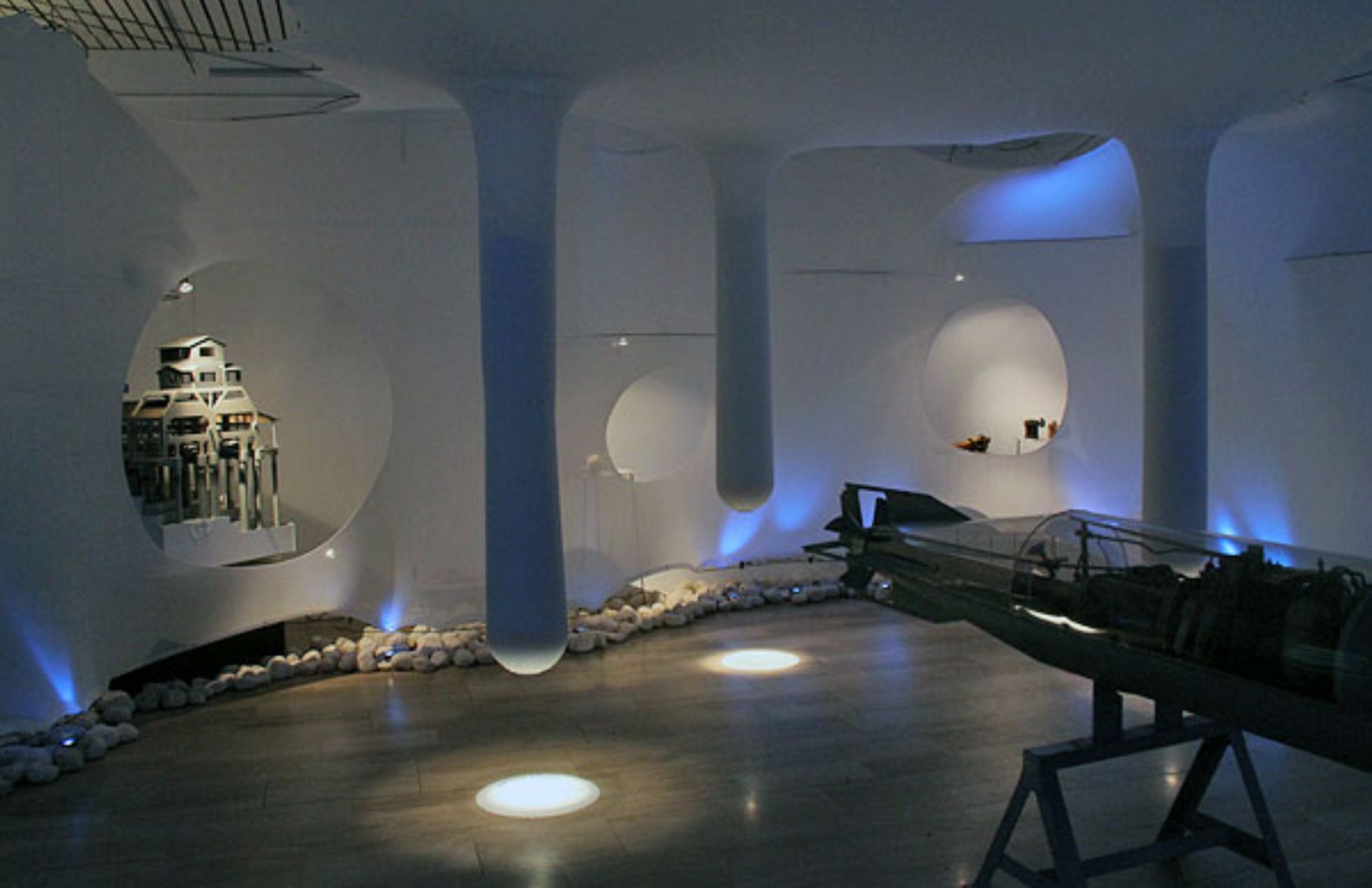
A short recap: in the 19th century, naval officer Ivan Luppis from Rijeka presented his model for an explosive floating device to Robert Whitehead, an English engineer who managed a factory in town. The design had some faults which rendered it unusable, so Whitehead built upon the original model and came up with the world’s first self-propelled torpedo.
Having secured investment from the Austrian government, Whitehead opened the first torpedo factory in Rijeka in 1870. It grew into a successful enterprise of international renown, producing up to 160 torpedoes a month by the middle of the 20th century.
Back to the exhibition… Torpedoes and related exhibits are displayed in an insanely atmospheric space, designed to evoke a sense of being underwater. Soothing audio backdrops and gentle lighting have a mesmerizing effect and make for an unforgettable learning experience - you’ll enjoy diving in.
Working hours: visit by prior arrangement only, contact +385 51 351 092 or +385 91 502 1231
Address: Žabica 4, Railroad Warehouse
Website: Torpedo of Rijeka
On to our next location, a short walk uphill from the main promenade Korzo. Several attractions included in the Winter Pass are to be found in and around the grand Governor’s Palace:
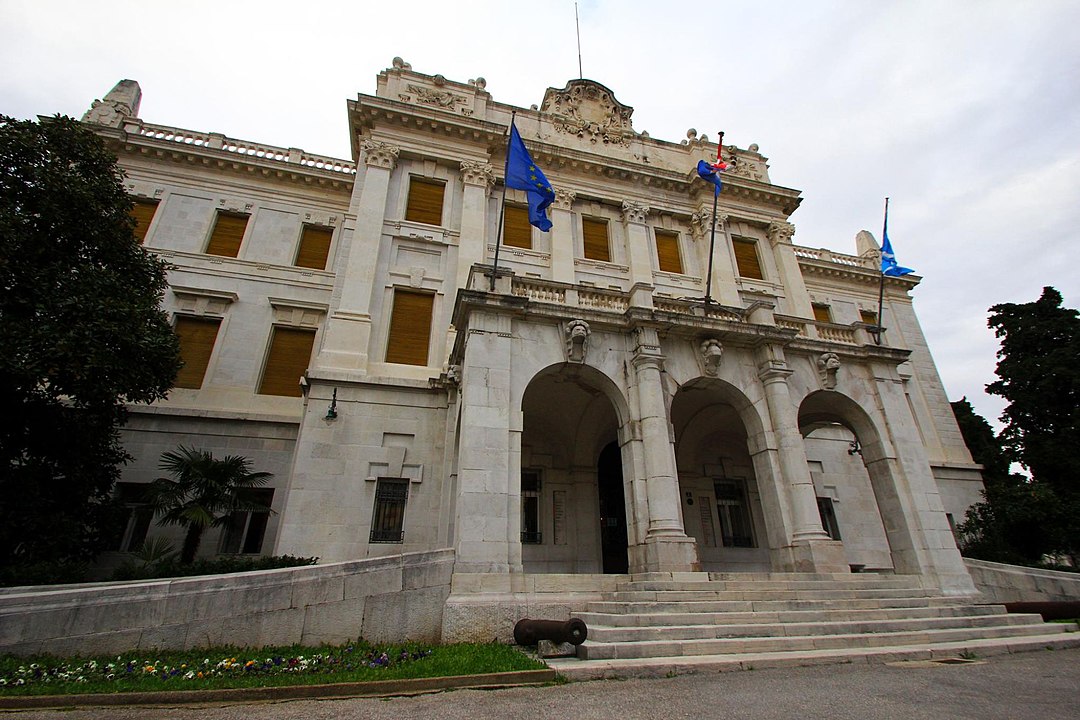
Zoran Kurelić Rabko
Maritime and History Museum of the Croatian Littoral Rijeka
What will you find behind this mouthful of a name? A lovely museum dedicated to the vast maritime heritage of the area, located in the stunning Governor’s Palace that overlooks the city center.
Their collection features one of the five remaining life jackets from the Titanic, the only preserved one in Europe - click here for a deeper look into the fascinating story.
Among all the objects and exhibits on display, the crown jewel is perhaps the building itself. A late 19th century masterpiece, the palace was built as the residence and seat of the city governor during Hungarian rule.
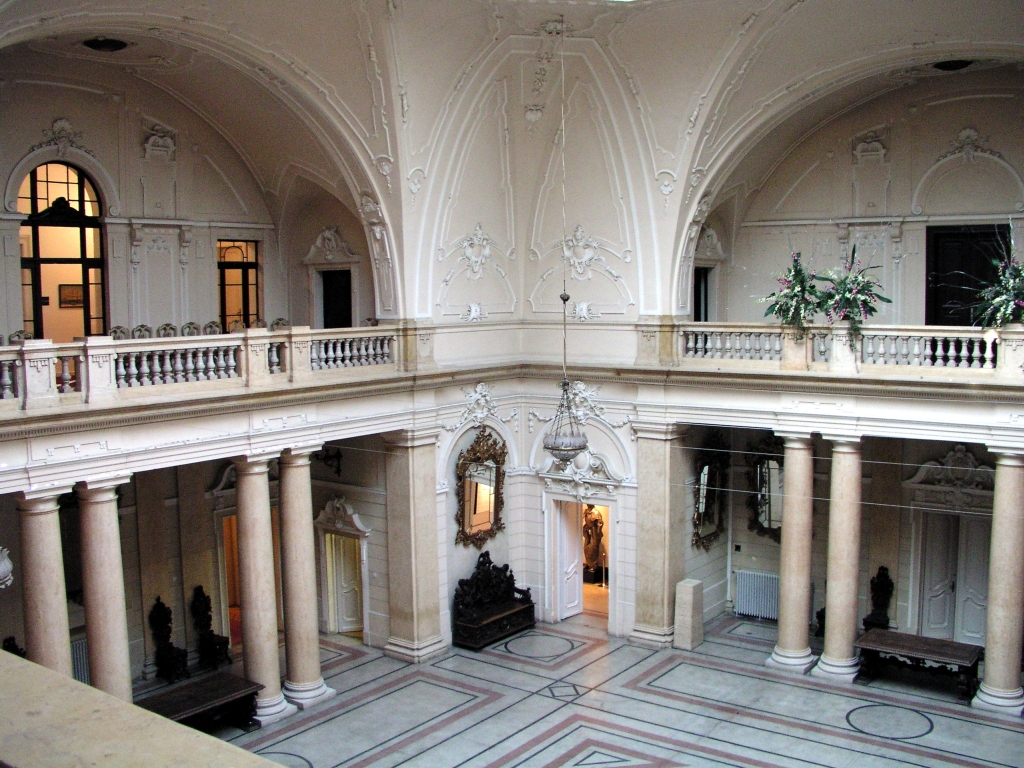
Image source: Roberta F on Wiki Commons
Designed in the neo-Renaissance style, the palace was furnished and decorated by local artisans and artists - not a common occurrence as Hungarian officials at the time typically preferred to employ their nationals on such projects.
The Governor’s Palace is alone worth a visit to the Maritime and History Museum - consider it sightseeing at its finest. Explore the collection in the many splendid salons and finish the tour with a short stroll through the garden.
Working hours: Monday 9am - 4pm, Tuesday - Saturday 9am - 8pm, Sunday 9am - 1pm
Address: Trg Riccarda Zanelle 1
Website: Maritime and History Museum
The “Cube”, Rijeka City Museum
Before the City Museum moved the bulk of its collection to the Sugar Palace, it used to be displayed at the Cube building (Kockica in Croatian).
It remains open to visitors and will continue to host temporary exhibitions related to the history of Rijeka. Aside from an occasional exhibition, there’s not much to see at the museum itself these days, but it’s worth checking out for the architecture that stands out against the historical backdrop of the city center.
Purposely built in the 1970s to house the museum and designed by Croatian architect Neven Šegvić, the Cube is known as one of the most notable works of modern architecture in Rijeka.
The museum is located to the left of the Governor’s Palace.
Working hours: Tuesday - Friday 4pm to 7pm; Saturday 10am - 2pm
Address: Trg Riccarda Zanelle 1/1
Website: Rijeka City Museum
Natural History Museum Rijeka
Take a short walk through the park east of the Governor’s Palace and you’ll find a 19th century villa housing the Natural History Museum.
The original permanent exhibit was designed after the Naturhistorisches Museum in Vienna, albeit on a smaller scale. Today, the museum collection features some 90.000 items related to the natural history of Rijeka and the region.
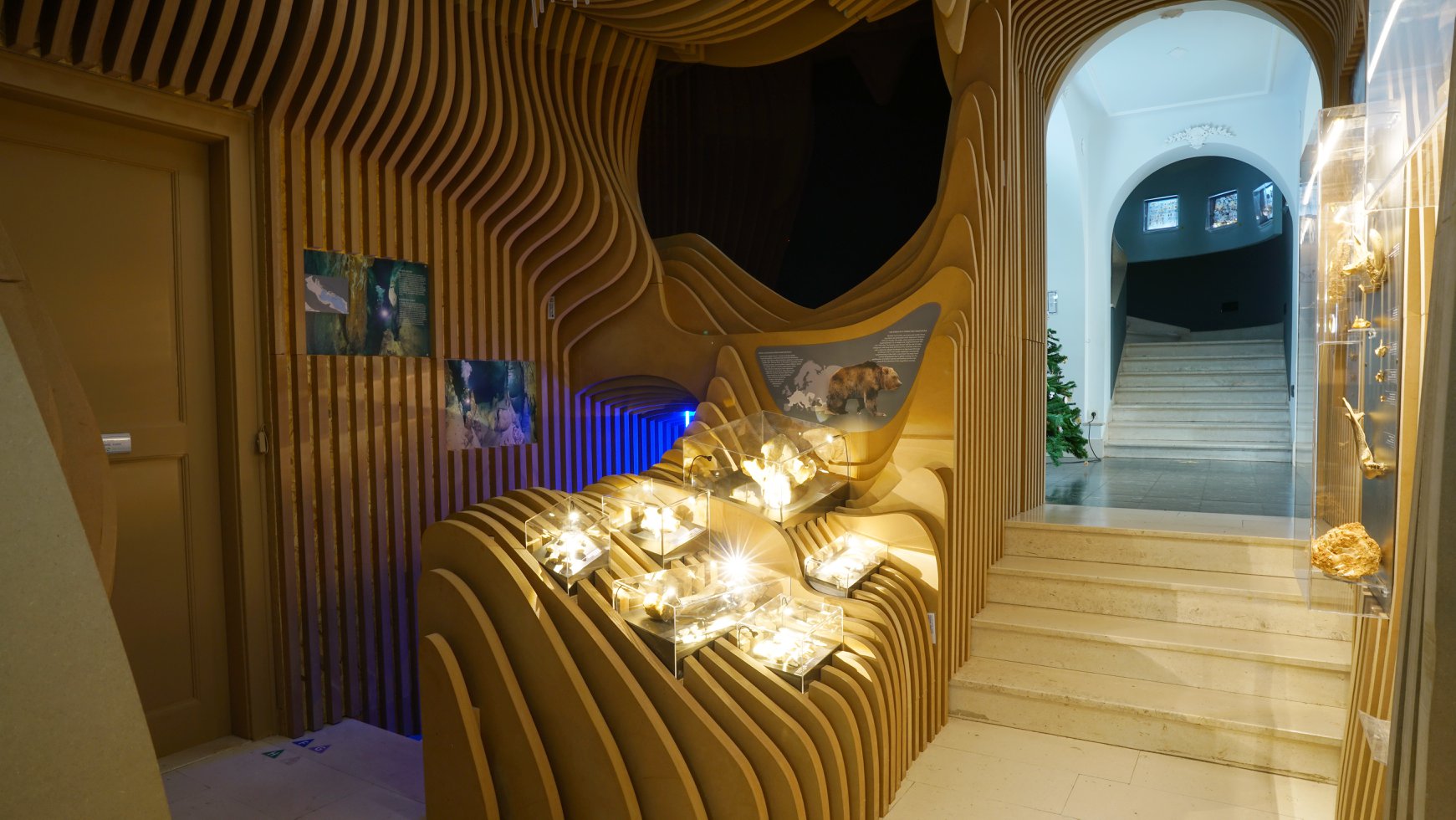
Natural History Museum Rijeka - Facebook
Numerous themed exhibits are displayed at the museum, including an aquarium, a mineral collection, a paleontology collection, and displays showcasing endemic and indigenous species from insects and reptiles to sharks.
It’s a fun place to explore and doubles as an educational visit - if you’re travelling with kids, make sure to stop by.
Working hours: Monday - Friday 9am to 8pm (break 3-4pm), Saturday and Sunday 9am to 8 pm (break 1-2pm)
Address: Lorenzov prolaz 1
The next two attractions are both located a few minutes’ walk from the Governor’s Palace.
Peek & Poke – Computer Museum
Need a change of scenery after all the regular museums? Here’s one that doubles as a time machine that everyone will love!
Peek&Poke is a display of vintage computers, gaming consoles, calculators and other bits of 20th century technology. Founded by a group of computer enthusiasts in 2007, the museum now houses a collection of more than 1000 exhibits sourced all over the world.
True to their name, they allow the visitors to poke at a good deal of displayed devices. Depending on your age, it’ll either be a trip down the memory lane or a rare opportunity to have a go at a few consoles of the past - enjoyable either way.
More fun awaits next door at the Museum of Childhood, run by the same crew as Peek&Poke. It’s a delightful display of children’s games, toys, books and other objects associated with childhood that were all used and loved in the past - the oldest exhibit dates to 1900.
The collection was built by citizens who loved the idea when the concept was first introduced and donated their old games and toys. It’s a heartwarming place that’s sure to induce some nostalgia; look around and see if anything brings back memories of the good old days.
Address: Ivana Grohovca 2
Working hours: October 15th to May 1st - Saturday 11am to 4pm. Prior arrangement is needed to visit Peek&Poke on other days of the week - contact them through this form
Website: Peek&Poke, Museum of Childhood
JGL Pharmacy Museum
Tucked away in the Old town in Rijeka is a unique destination that’s sure to spark your curiosity. Explore the hissstory of pharmacy, invites the friendly snake on the wall - the symbol of medicine and mascot of the JGL Pharmacy Museum.
The specialized museum presents the history of pharmacy on a global scale with a focus on Croatia. They’ve done a superb job with the permanent display, where VR and AR meet authentic historical exhibits such as vintage tablet-making machines and a 1909 cash register.
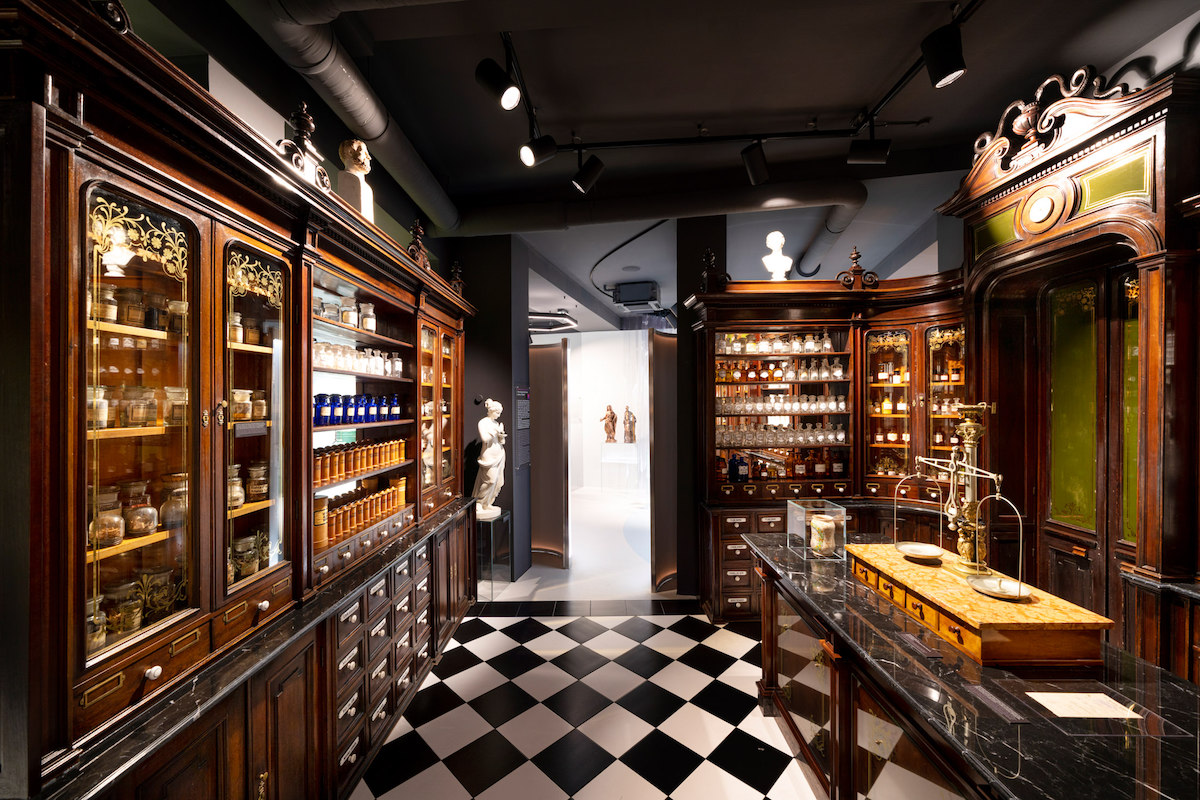
© JGL Pharmacy Museum
The star of the show? The central exhibit, an impeccably recreated front-end space of a typical pharmacy from the first half of the 20th century.
In case you’re wondering, the JGL in the name stands for Jadran-Galenski Laboratorij, a Croatian pharmaceutical giant that established the unique museum in collaboration with the Rijeka City Museum.
Working hours: Tuesday to Saturday 10am - 7pm, Sunday 10am- 2pm
Address: Užarska ulica 11
Website: JGL Pharmacy Museum
Guided tours available upon request (price: 120kn)
And finally, three notable attractions outside the city center:
Trsat Castle
Perched on a hill above the city, the Trsat Castle offers a phenomenal view over the city and the Kvarner Bay, best enjoyed with a cup of coffee or a cocktail at the courtyard café.
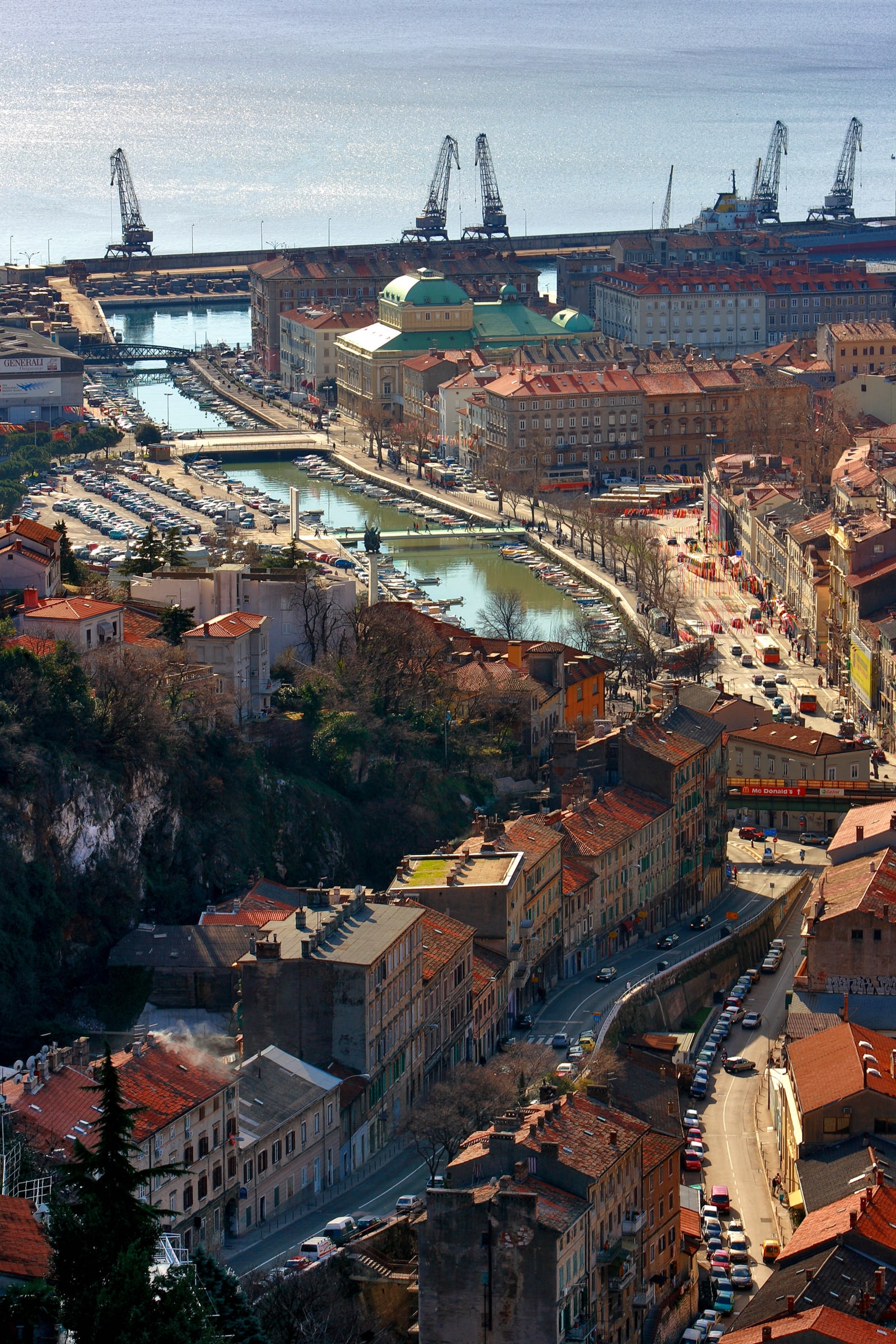
Romulic and Stojcic
It’s a lively location these days, currently hosting a grand Advent programme that has the castle wrapped in Christmas lights - 11 kilometres in total!
The castle had a pretty eventful history: it was built by the noble family Frankopan in the 13th century and was later owned by Venetians and the Habsburgs. The present layout is owed to Laval Nugent, an Austrian field-marshal of Irish origin who got possession of the castle in 1826.
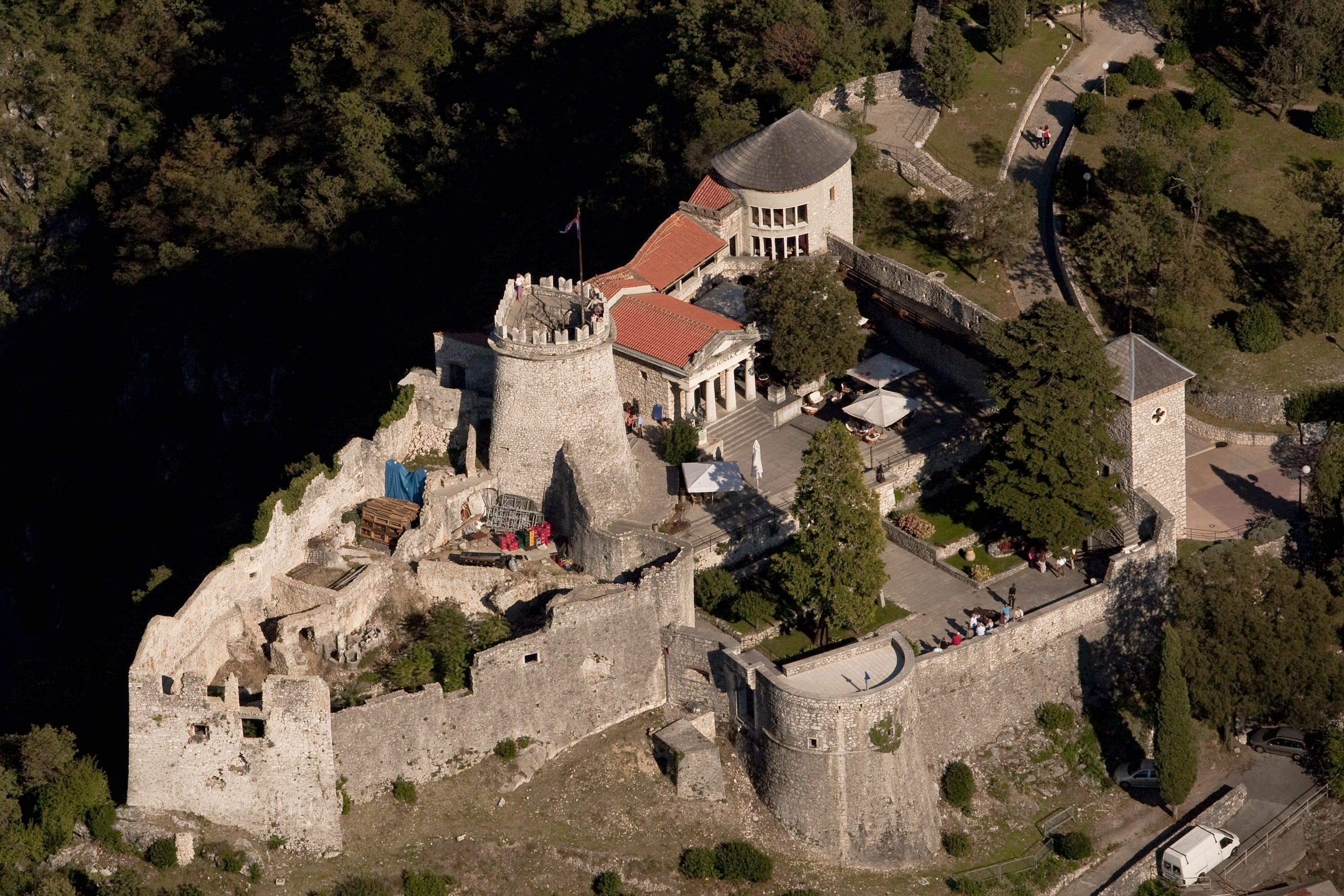
Romulic and Stojcic
Nugent restored the castle and expanded the structure with a few additions, the most notable being his family mausoleum whose entrance is guarded by two peculiar creatures - read more here.
There’s a lot to do here beyond enjoying the vistas. The castle grounds host food festivals and cultural manifestations throughout the year, with plenty of concerts and plays taking place in the summer months. The fort is also home to a sleek interpretation centre for visitors, one of the stops on The routes of the Frankopans, a cultural-tourist route you can learn more about here.
Working hours: entrance to the castle grounds 9am - 12am daily; interpretation centre for visitors: Monday to Friday 9am to 5pm, Saturday and Sunday 10am to 6pm
The Astronomical Centre
Opened in 2009, the Astronomical Centre in Rijeka is the only such facility in Croatia that has both an observatory and a planetarium.
It’s located on a hill outside the city centre, in a former fortress built during World War II. Thoroughly renovated, the centre now features the only planetarium in the region that uses digital technology.
There are several reasons to visit the Astronomical Centre. If you’re fascinated by space, you can attend one of the presentations or films about the universe, screened on the ceiling of a spherical dome:
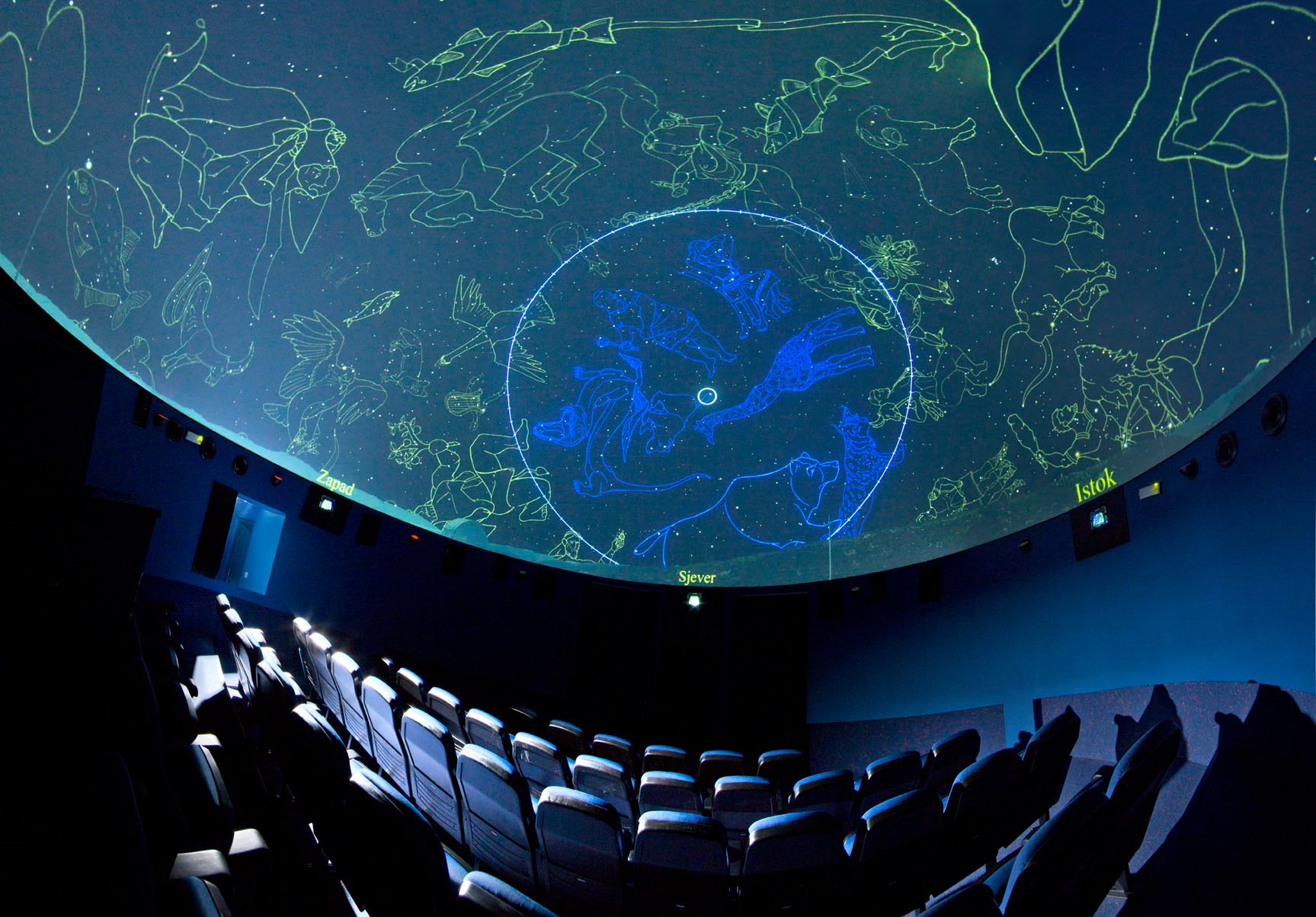
© Astronomical Centre Rijeka
Quite a unique venue, but there’s more: the rooftop of the Astronomical Centre offers one of the best views in Rijeka any time of day, but turns absolutely spectacular at night. It’s a perfect place for evening drinks (yes, there’s a bar), with the shimmering lights of Rijeka and the Opatija riviera reflected in the Kvarner bay.
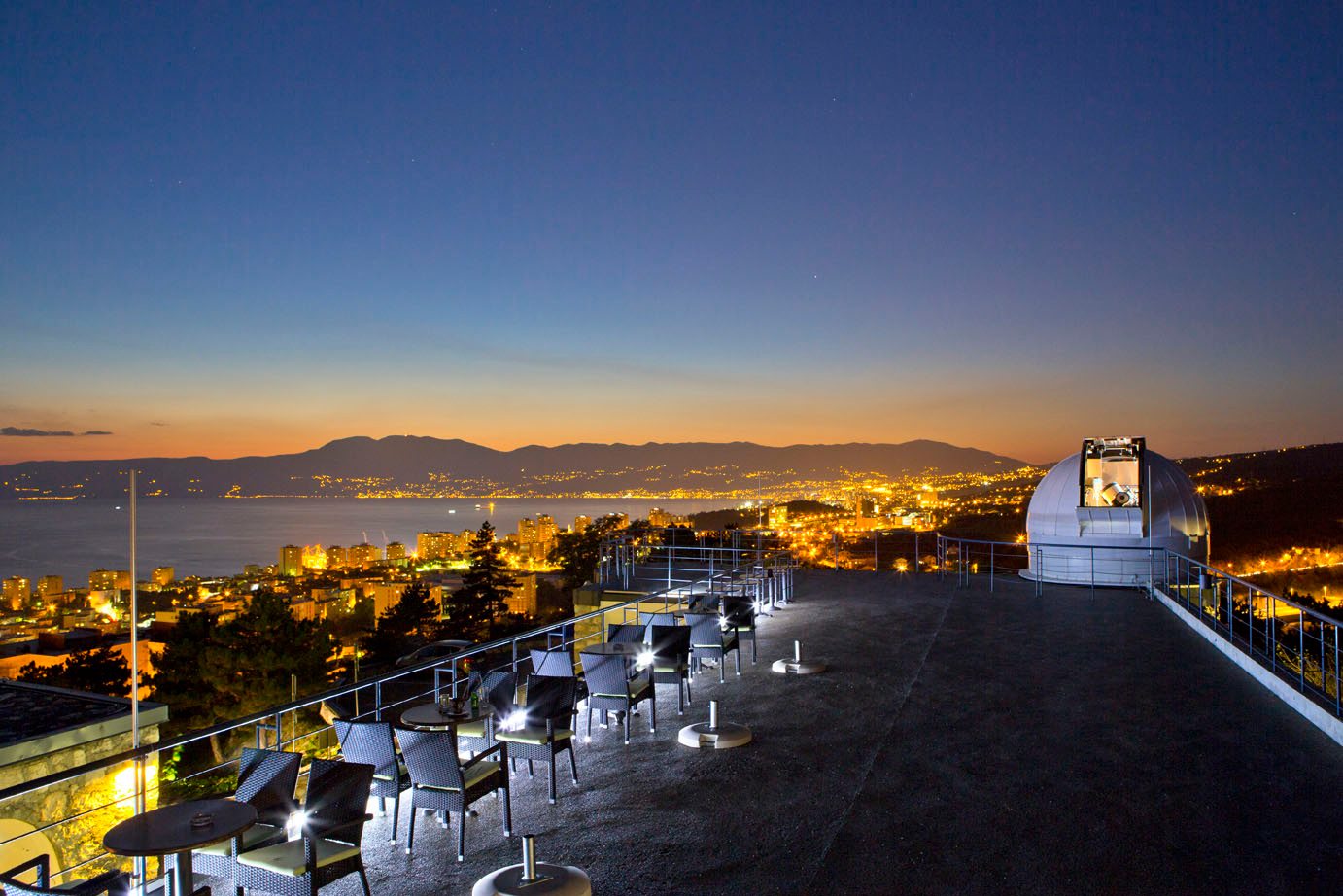
© Astronomical Centre Rijeka
The facilities of the Astronomical Centre are wheelchair accessible.
Working hours: Tuesday - Saturday 8am to 10pm
Address: Sveti križ 33
Website/event schedule: Astronomical Centre Rijeka
Swimming Pools Kantrida
How about a few laps in the pool for a change of pace after all the sightseeing? Fans of active vacations can use their Rijeka Winter Pass to avail of free use of swimming pools in the city neighbourhood Kantrida.
The Kantrida swimming pool complex consists of five pools: indoor and outdoor Olympic pools, a 25m pool, a children’s pool and a diving pool. The facilities meet the standards of largest water sports competitions and are entirely wheelchair accessible.
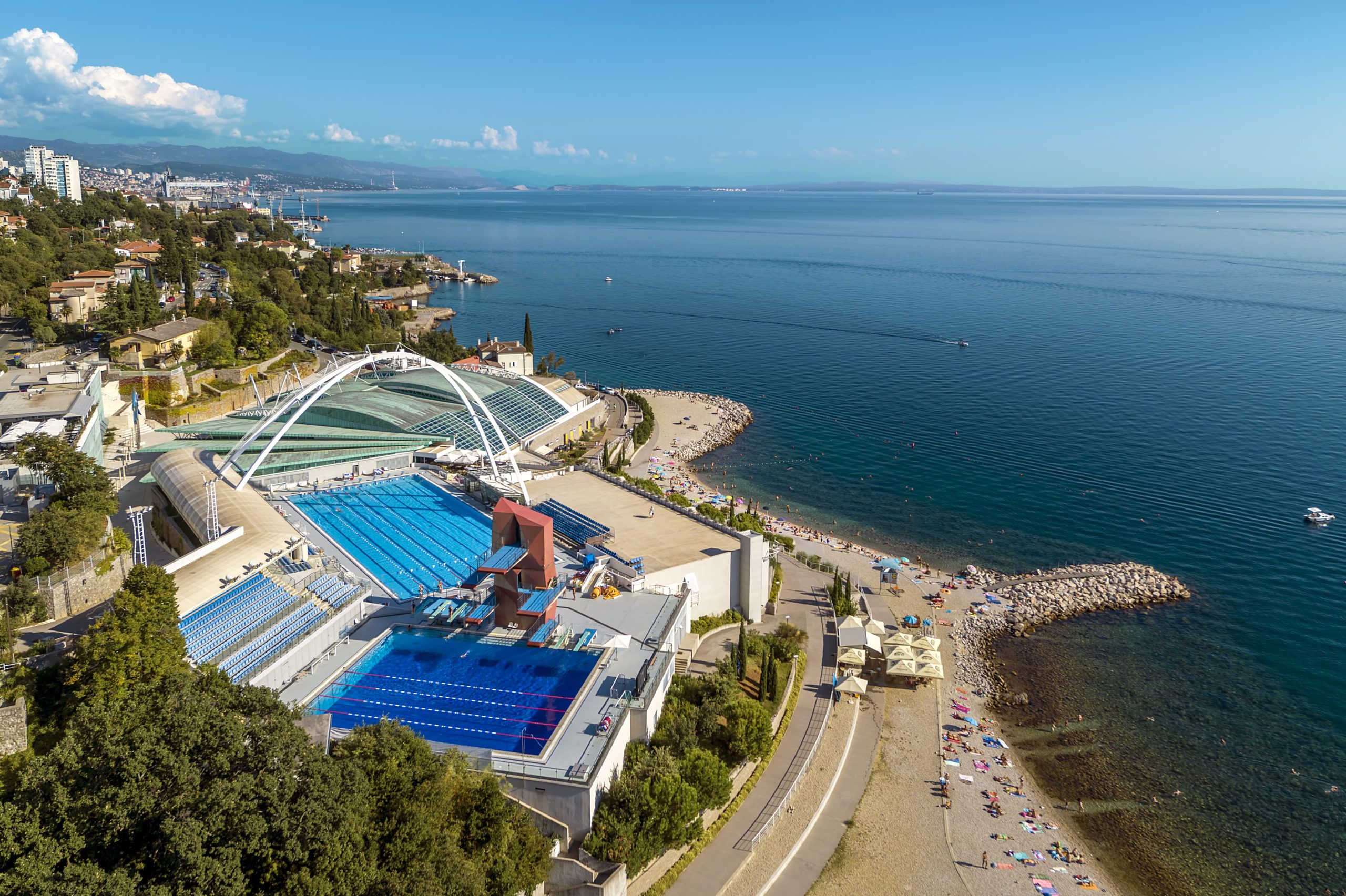 © Visit Rijeka (visitrijeka.hr)
© Visit Rijeka (visitrijeka.hr)
Added bonus: the sports complex is situated right above the beach. We don’t expect many enthusiasts wanting to take a dip in winter months, but it’s a lovely spot to have a coffee with a view or take a short walk by the sea.
Working hours: Mon, Tue, Wed and Fri 7am to 10pm, Thu 9am to 10pm, Sat 7am to 4pm, Sun 8am to 3pm
Address: Podkoludricu 2
Check out the timetable to see when the pools are open to the public.
2021 World Championship: Japan Tops Croatia Women's Handball 28:26 in Last Group G Game
December 6, 2021 - The Croatia women's handball team lost to Japan in the last game of Group G at the World Championship in Spain. Japan topped Croatia 28:26.
Croatia entered this match without three important players, Ćamila Mičijević, Ivana Dežić, and Dora Krsnik, who are out of the squad after testing positive for Covid-19. Coach Nenad Šoštarić had 10 players and three goalkeepers at his disposal for the match against Japan.
Croatia fought a great battle against a persistent, tough, and quick Japan, led about 50 minutes of the match, but were left without strength in the end. Croatia did not score a goal in the last seven minutes, and after leading 23:20 in the 46th minute, they fell behind 24:26. Mistakes plagued the end of the match and defeat was inevitable.
Larissa Kalaus scored six goals for Croatia and Ana Turk five, while Nakayama led Japan with nine goals.
Croatia played against Japan only once before at the 2005 World Championship in Russia.
The match against Japan was important because the winner transfers two points to the second round. Three national teams advance from each group. After that, four new groups of six teams will be formed, and the national teams will transfer the points won against other teams from the group to the second round.
Thus, Japan will transfer two points to the second round of the competition, while Croatia will not transfer any, because they only won against Paraguay, which ended its journey in the championship.
In the second match of the group, Brazil defeated Paraguay 33-19. Thus, in the second round, Brazil transferred four points, Japan two, and Croatia no points.
In the second round in Alicante, Croatia will play Spain (4), Argentina (2), and Austria (0).
Recap
CROATIA: Bešen (0+1), Kapitanović, Pijević (6); P. Posavec 3, S. Posavec 3, Kalaus 6(3), Ježić 4, Burić, Šimara, Debelić 4, Turk 5, Mamić, Blažević 1. Coach: Nenad Šoštarić.
JAPAN: Kametani (8+1), Baba; Nagata 1, Fujita, Gray, Ohyama 1(1), Aizawa 3, Matsumoto, Iwabuchi, Kondo 2, Nakayama 9(4), Yamamoto, Kitihara 4, Sahara 2, Hattori 6(1), Yoshidome. Coach: Shigeo Kusomoto.
7-meter throws: Croatia 4(3), Japan 9(6).
Exclusions: Hrvatska 8 minutes, Japan 12 minutes
Player of the match: Kaho Nakayama.
To read more about sport in Croatia, follow TCN’s dedicated page.
Taste Croatia: The Mediterranean Diet (VIDEO)
December 18, 2021 - Food is the first thing everyone thinks of when talking about the Mediterranean Diet, and while it's food that weaves all the elements of the Mediterranean diet together, over the past three months we've learnt that the Mediterranean diet is so much more than just food.
Healthiest Food Choices
Chances are you have heard of the Mediterranean diet, not only for its deliciousness but also for the fact that the Mediterranean diet has long been known as one of the healthiest food choices.
The US News & World Report rating the best diets for 2021 had the Mediterranean diet top the scales as the best diet overall in the annual best diet rankings for the fourth consecutive year being described as extremely delicious, easy to follow, easy to get started, and very sustainable.
Uniquely Croatian Twist
Living in such a beautiful region as part of the Mediterranean, tourists flock to Croatia to taste, if just for a few days, the Mediterranean diet. A big part of that is enjoying the amazing fresh fare that is on offer, with its own uniquely added Croatian twist. All the way from the top north regions of Istria to down south of Dubrovnik you can find delicious, fresh, and healthy food.
Sure, you can try Mediterranean cuisine halfway across the world, and the key to your enjoyment is in the ambiance that comes along with the fare. Take your pick, anywhere you choose, whether inland or on the islands, you will find a treasure trove of specific ingredients that are still being grown and prepared using traditional methods. Along with Spain, Italy, Greece, and Morocco, the Croatian islands of Brač and Hvar are centres of protected Mediterranean cuisine, since a part of the ingredients and spices, as well as the customs surrounding the preparation of some dishes, represent a shared cultural heritage.
“Your body is not a temple, it’s an amusement park – enjoy the ride.” These are the words of one of the world’s most famous and beloved chefs, Anthony Bourdain, and words to live by when it comes to the Mediterranean cuisine on the Adriatic.
More Than Just Food
Take the time and you will realise that the Mediterranean Diet goes beyond being only an exceptional dietary pattern. There is an entire culture around the production, preparation, presentation, and consumption of food. The real Mediterranean diet is so much more valuable to us than just eating fresh, wholesome food. From buying or growing, to preparing and eating Mediterranean meals can vary across the region, with Peka here in Croatia to Paella in Spain.
The Mediterranean Diet involves a lifestyle, a Mediterranean dynamic cultural complexity, which includes traditions concerning agriculture, fishing and livestock, food processing, preservation, cooking techniques, food sharing, and consumption. Cooking and meals are perfect social meetings to exchange ideas and communicate with family, friends, and neighbours, to forge closer ties, in cordiality and respect.
The Mediterranean Diet has a main role in culture, being present in festivities, celebrations, and daily life, represented in crafts, in markets, as places for exchange, or inside the familiar nucleus, where techniques and recipes are transmitted.
Med Diet Declaration
The Med Diet Declaration aims to achieve greater visibility and significance of the Mediterranean diet across all sectors, such as agriculture, food production, health, culture, sport, education, economy, tourism, rural development, and sustainability.
Endorsing this declaration is an opportunity for local and regional actors to demonstrate the crucial role they can play in strengthening the economic potential of the Mediterranean diet in rapidly changing landscapes and lifestyles. This call is therefore an invitation to join the Med Diet Declaration community, a badge that highlights an active role in DEFENDING, PRESERVING, and PROMOTING the Mediterranean diet.
Med Diet Endorsers
We were thrilled to be chosen to be part of this project and work with the first Endorsers of the Med Diet Declaration here in Croatia. To meet families who for generations have been sustaining their lifestyle by promoting and living the true Mediterranean Lifestyle. In this video we introduce you to two of the Med Diet Endorsers:
MALI RAJ, BOL, ISLAND OF BRAČ
Mali Raj translated into English means little paradise. And that's exactly what you feel as you arrive at the restaurant with it being located in a most beautiful setting just above the beach 'Zlatni Rat'. It's not just the setting that creates this atmosphere. The food is heavenly too, reflecting traditional Dalmatian cuisine with some of the most interesting recipes being added to the menu, with various types of tartar, carpaccio, and buzara.
RESTAURANT TRICA GARDELIN, VRBOSKA, ISLAND OF HVAR
Another island favourite is Restaurant Trica Gardelin, a family-run restaurant in the picturesque village of Vrboska. Their love of the Mediterranean diet is seen not just in their business, it weaves its way through every aspect of their lives. And their motto "from the sea to your plate" has been confirmed by us on many occasions and by many of our guests, both local and visitors to Croatia.
For more information about the Med Diet Declaration - read here
For more information Travel/Lifestyle in Croatia follow TCN's dedicated pages - Lifestyle | Travel
If you have questions on anything sailing in Croatia, feel free to ask below in the comments or check out Total Croatia, Sailing in Croatia: Your One-Stop-Shop for everything sailing.


